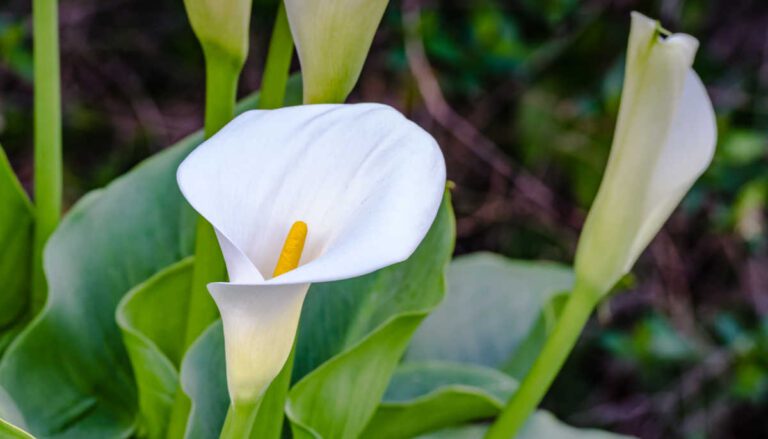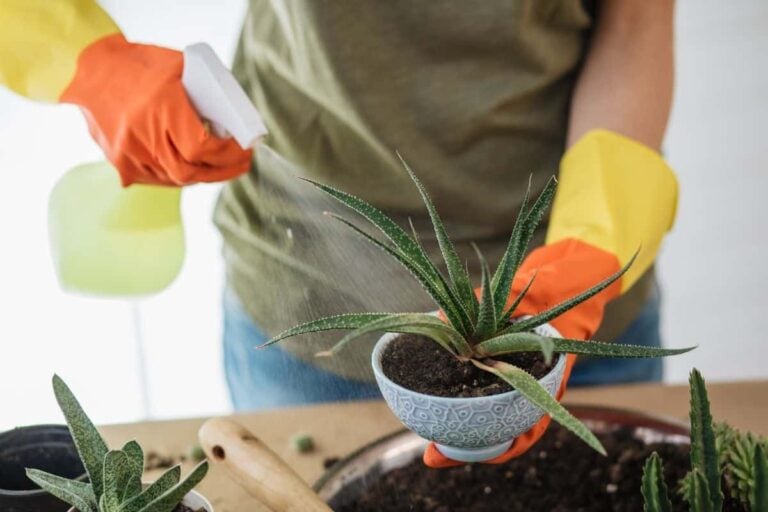30 Different Types Of Lilies (With Pictures) & How To Grow Them
Lilies are some of the most beautiful flowers in the world.
Whether it’s their wonderfully delicate, curling petals, or their fascinating anthers within their center, lilies offer some of the most visually satisfying plants available.
They brighten up any garden! However, you’ll probably be surprised to learn that there are many more varieties than the typical white ones you see.
Well, there are well over 90 different species of lily that exist, with thousands of varieties housed within that.
These are often broken down into “Divisions”, which divide the varieties and species up into groups based on their physical qualities and origins.
In this guide, we’ll be looking at each division and some of the best breeds of lily that you can grow from them, describing their characteristics.
On top of that, we’ll give a small look at just how lilies came to be – as well as a detailed guide on how you can grow and care for your own.
After you’ve picked some out from our list, of course! So, read on and get planting.
A Brief History Of Lilies
As Europeans explored continents, they found new lily species all over the world – North America, Asia, Japan. They brought them back, and by the 1920s the number of lily varieties was growing massively.
A man named Jan de Graaff began to make a breeding program for lilies, and his Oregon Bulb Farms were responsible for lots of hybrids – which you’ll read about soon!
Types Of Lilies
Below, you’ll find examples from each division of lilies – including their individual qualities!
Division 1: Asiatic Hybrids
The first division of lilies are great for a number of reasons. For one, they’re the earliest bloomers of all of them, which is useful because flowering early will give you quicker results.
Secondly, the Asiatic division has the best variety of colors of any division, offering yellows, oranges, pinks, reds, whites, and more! The only color they don’t offer is blue.
On the whole, they tend to reach about four feet tall, growing about 2.5 feet in their first year, then less from then on.
There is a downside, however, and that’s that they don’t have a scent. This can be a great shame for flower lovers who like to enjoy the fragrance of their garden.
Their wonderful colors, though, will surely make up for it!
Tending To Asiatic Hybrids
Whether they’re planted in a plot or a flowerbed, you want them to have good drainage. To make them live longer, harvest them when their lower buds begin to show color, but haven’t opened.
Orange Pixie Lily
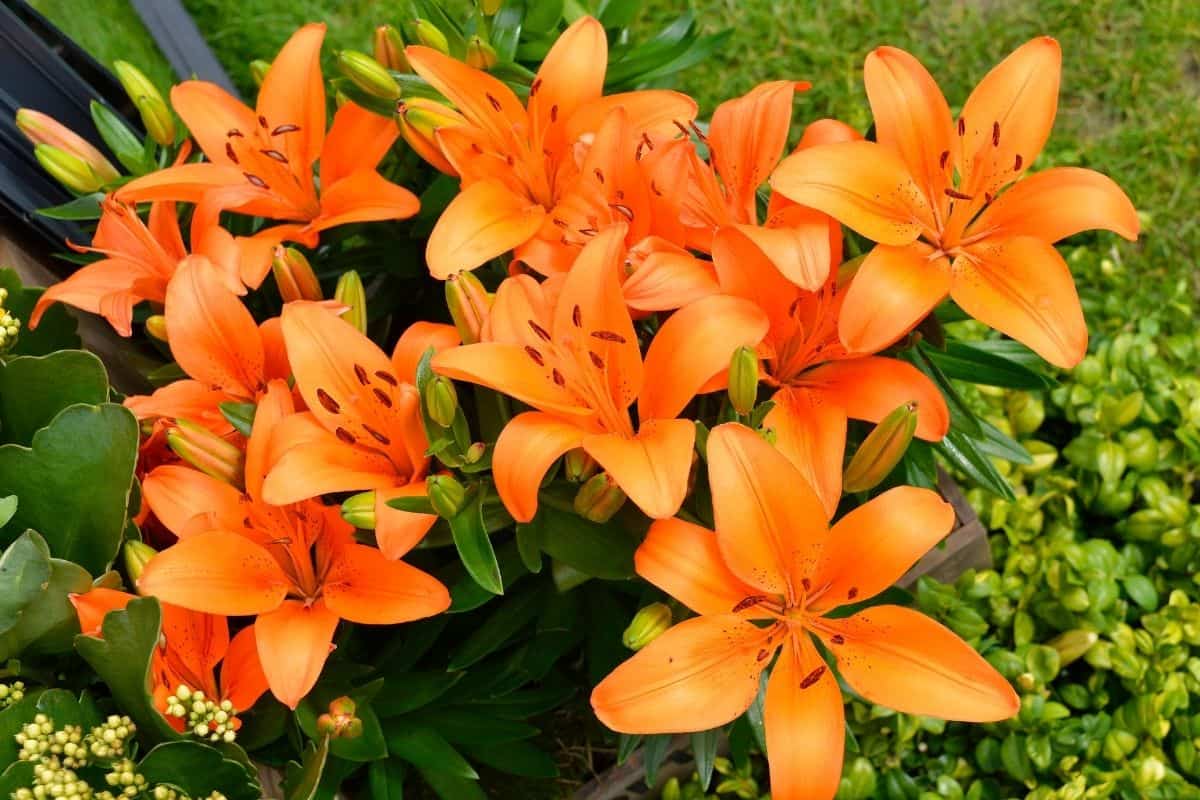
This beautiful orange lily has a fiery feel to it, though is quite short, growing to a maximum of 18 inches (1.5 feet) with the flowers included.
The “pixie lilies” are part of the “dwarf Asiatic” variety, small flowers that bloom early (this blooms mid-year, from June to August), meaning you can have a variety over the year.
They go well in small gardens with some sun, and grow in zones 2 to 9 (which refers to conditional zones across America).
Denia Pixie Lily
Another pixie lily, this will grow to about the same size, 1.5 feet. They have a more subdued look, with soft pink petals with brown spots.
They suit small gardens also, with a mixture of full or occasional sun, and are best in the zones 3 to 8.
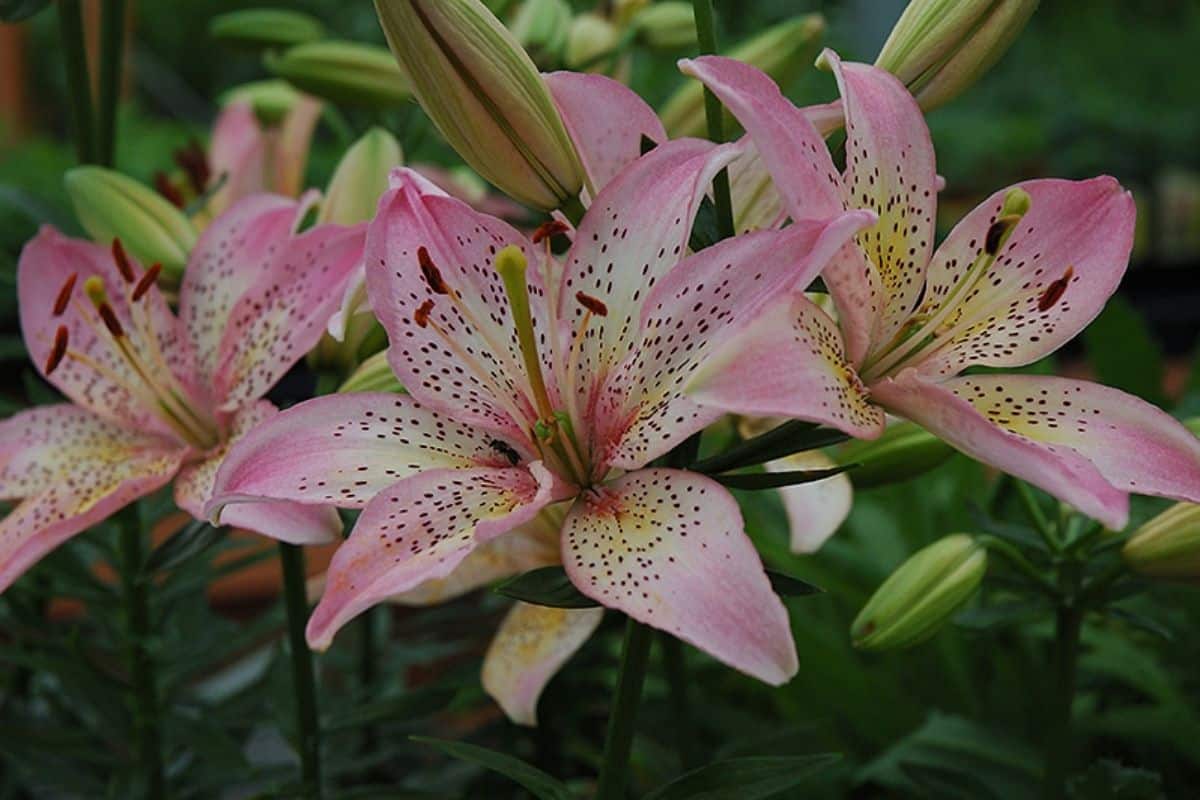
Connecticut King Lily
There are bright, big yellow flowers. They have some height, reaching 3 feet at maximum, and do best with only some sun.
They also bloom best mid-year, in June, and should only be grown in the zones 4 to 8 across America.
Like all Asiatics, they don’t have a scent to them.
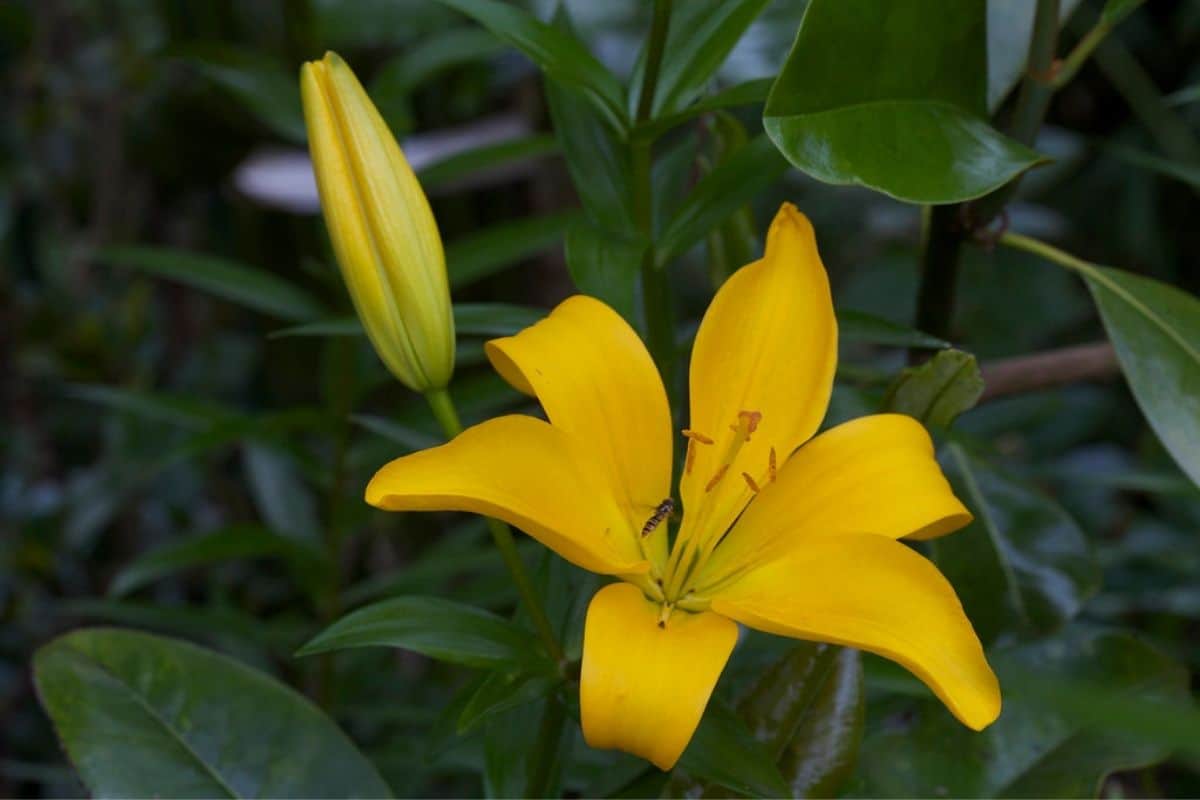
Roma Lily
These are gorgeous, cream colored flowers that come from pink buds. The finished flower looks rather like vanilla, which is funny because their brown anthers look like vanilla beans!
They have good height to them growing 4 feet, and bloom at the start of summer.
These flowers flourish from full sun exposure, and grow best in the zones 3 to 9, so ideally you live there.
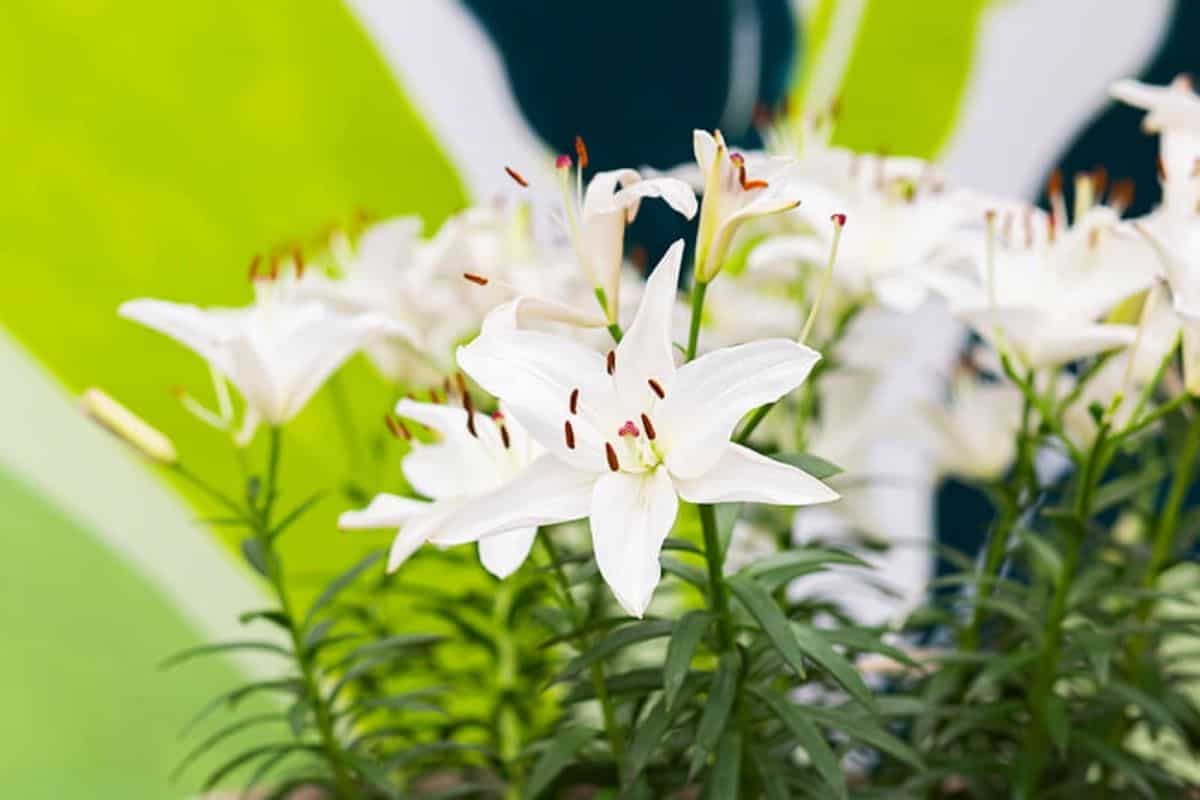
Enchantment Lily
More fiery orange flowers, these have some brown freckles too for variation. They reach heights of about 3-4 feet, also blooming in the summer season and enjoying full sunlight for growth.
The zones 4 to 8 across America will give them the right conditions for growing, too.
Another quality of the Enchantment Lily (Latin name, Lilium Enchantment) is that they are great for reproducing.
Each stem leaf should have little bulbs (known as “bulbils”) on their apex, when not flowering, and these can bulbs can be harvested about 2 months after things have flowered.
If you love the color of Enchantment, then this is a great and easy way to get lots more of it in your garden color pallet.
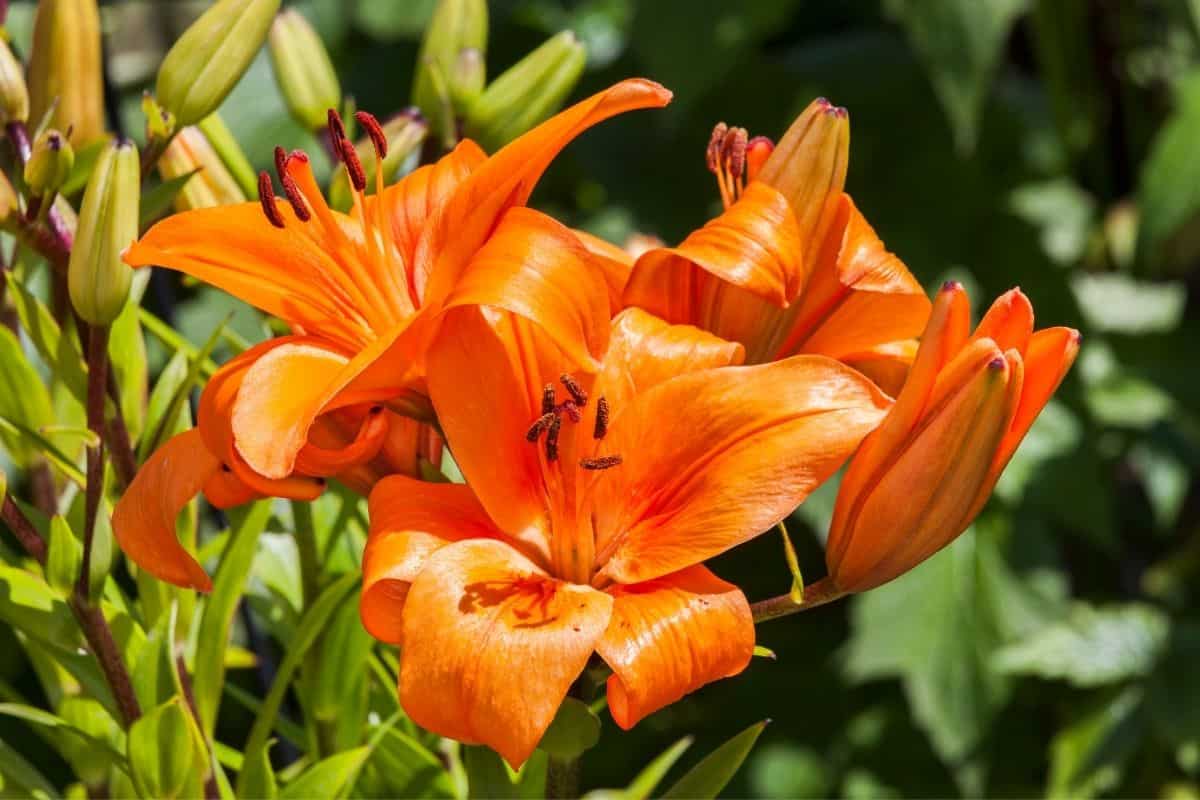
Division 2: Martagon Hybrids
Like the Asiatic, these are also early bloomers, allowing you to get them in flower nice and early on.
However, while many Asiatics like some full sun weather, the Martagon actually grows best in colder climates, preferring the shade to the sun’s full heat.
As for the flowers themselves, they have small flowers that face downward to the ground. They also have whorled leaves, which is when there are at least 3 leaves equally spaced around a node.
On top of that, they have pendent like flowers that come on tall spikes.
Martagon Hybrids often come from breeding other types of flower together, in this case the martagon variety and the Japanese turk’s-cap lily.
Tending To Martagon Hybrids
You’ll want to keep these out of the sun, instead putting them in the shade, where they can keep much colder.
As for soil, they like a good amount of drainage, but won’t die if it’s ot an excellent standard.
Marhan – Lilium X Dalhansonii
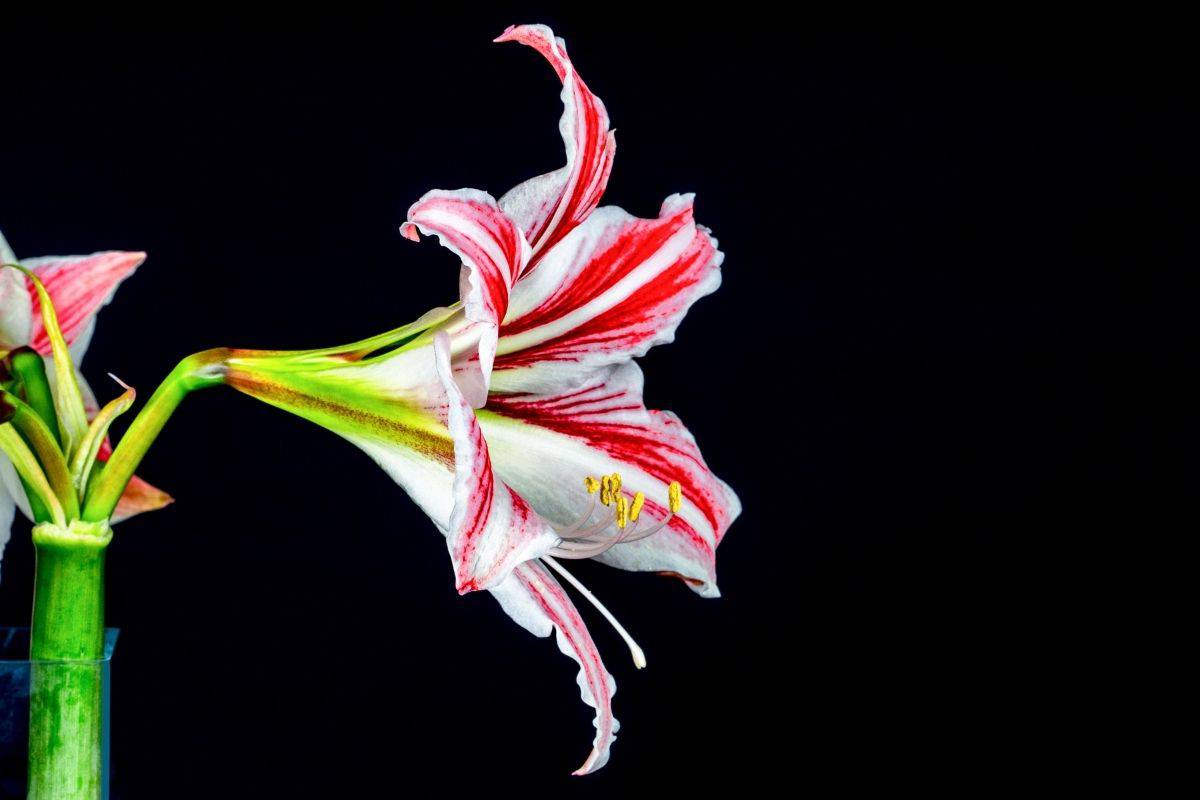
A beautiful freckled, salmon-pink or honey color plant.
This hybrid resembles its flower parents, the martagon and the turk’s-cap (also known as “hansonii”), though its petals aren’t quite as strongly bent and curvy as they both have.
They can grow to be quite tall, reaching about 4-6 feet. They grow best in zones 3 to 7, blooming in the early summer and mostly enjoying shade. Partial sun is sometimes recommended, but shade is best.
Division 3: Candidum Hybrids
Also known as the Madonna Lily, this is one of the most recognized and popular lilies in the world – the pure white lily.
As you can tell from its Madonna name, it has connections to religion, and dates back around 4000 years at least.
Yet, despite the popularity, it has barely been used to make cultivars. The lilium x testaceum is practically the only Candidum Hybrid, and is rare on top of that.
For this reason, you’re unlikely to be planting any. If you did, though, they bloom from late spring to early summer.
Division 4: American Hybrids
These come from the wild lilies of North America, specifically the Leopard Lily (Latin name, lilium pardalinum).
If the climate is cold, they bloom in the middle of summer, whereas if the climate is hot, they tend to bloom in late spring.
As for the appearance, they have pendent blooms and their bulbs spread outwards over time (because of their rhizomatous bulbs). On top of that, their foliage is whored.
Tending To American Hybrids
If you’re planting at home, plant them alongside shrubs for the best results. If you have access to woodlands, those work great too!
You must be careful when handling them, though, as the rhizomatous bulbs need delicate movement and lifting.
Cherrywood Lily
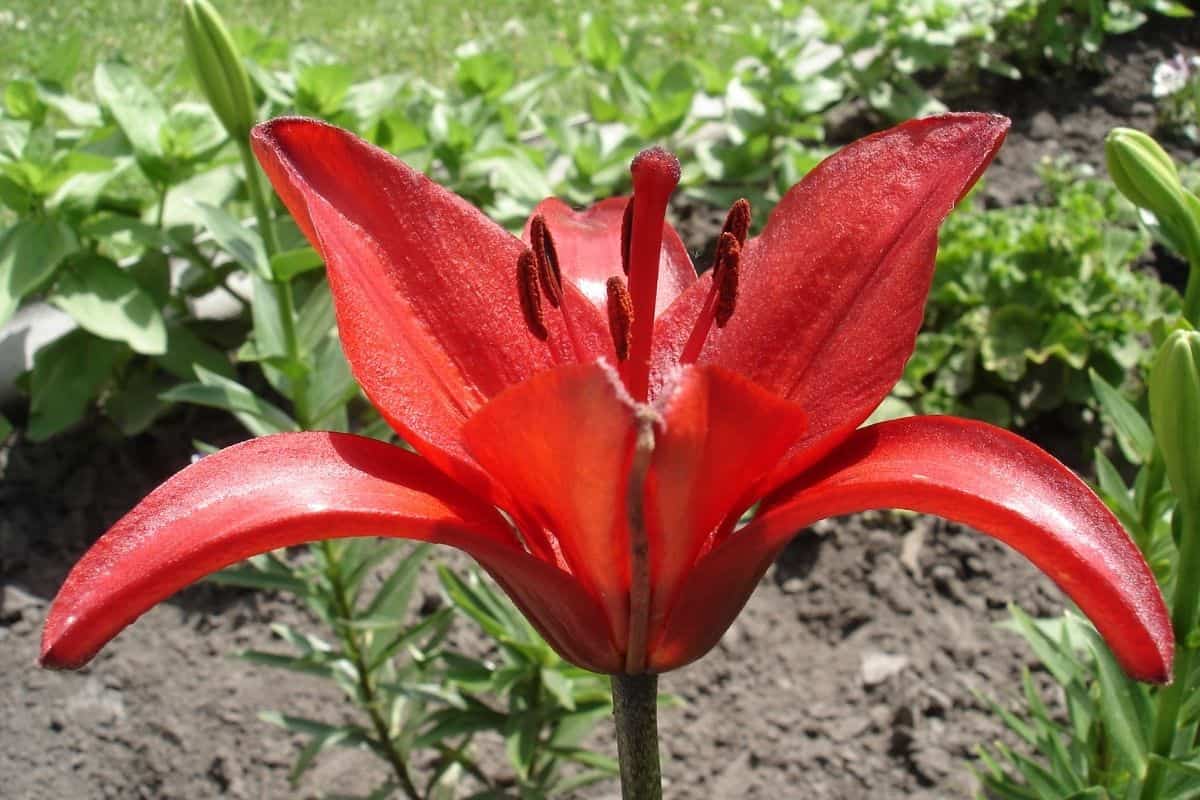
These tangerine flowers are beautiful, with red tips at the ends of the petals and red dots all over.
On top of that, the flower has whorled foliage all across the stems. It’s a tall plant, too, reaching heights of about 5-6 feet.
In terms of weather, this is going to enjoy being fully in the sun for it to grow best. It likes light and heat, blooming in the middle of summer, and is best grown if you live in the zones 4 to 8 across America.
Bellingham Lily
These will bloom in bright and full colors: orange, red, yellow. They have a real presence, with tall spikes covered in whorls of green leaves on them.
On top of that, they have lots of brown and black freckles all over their leaves. Their anthers are vibrant oranges and reds, just like the petals.
Like Cherrywood, these grow to impressive heights, lifting to about 5-6 feet at full bloom. Similarly, they also like to have lots of sunlight, growing best when left out of the shade and the cool.
For this reason, they also bloom in the middle of summer, benefitting from the increased heat of the season. You also need to grow them in the right areas across America, with them liking zones 4 to 8 the best.
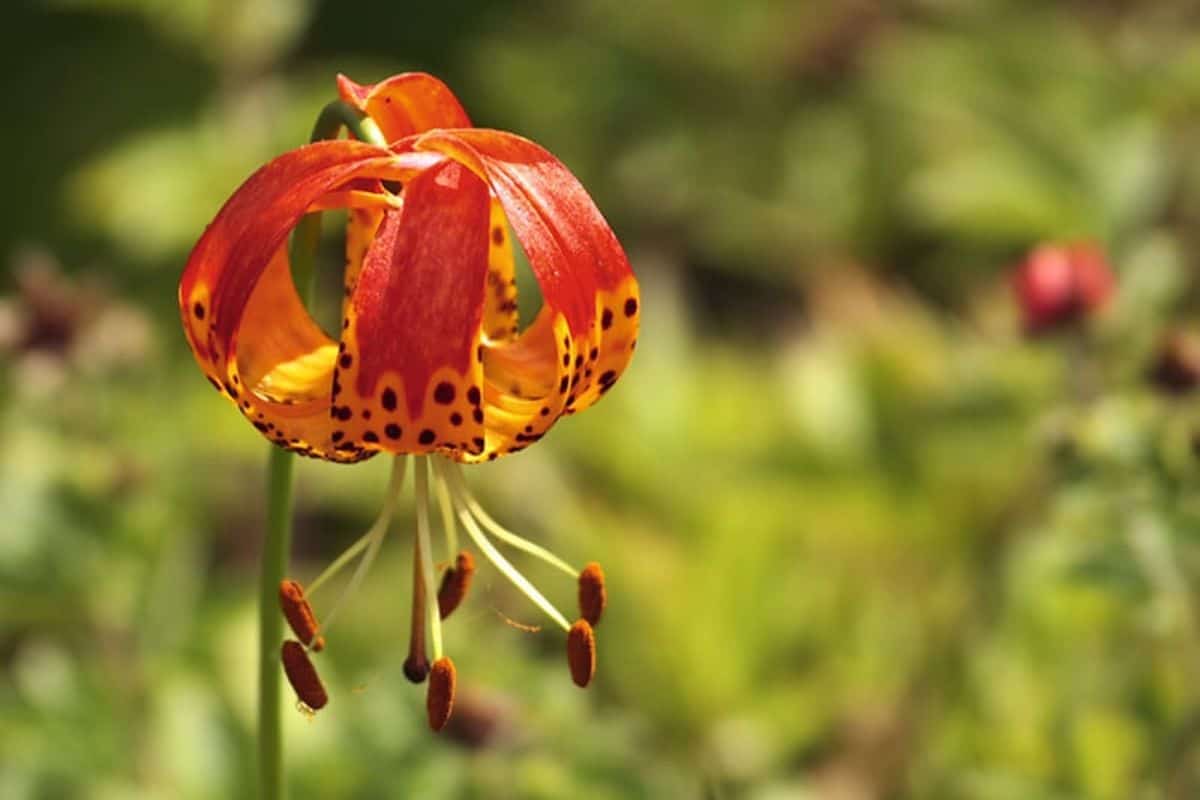
Division 5: Longiflorum Hybrids
These are often referred to as the Easter Lily, popular around Easter time. This is probably because of their calming pure white colors, yellow centers, and beautifully strong smells.
Its flowers are trumpet shaped, growing to impressive sizes of about 7 inches (half a foot), and they originally hail from Japan and Taiwan.
Tending To Longiflorum Hybrids
However, they are notoriously difficult to grow and keep surviving.
The flowers are extremely tender, meaning that they probably won’t survive any really cold weather, so they are often kept to the warmer Easter times.
They are unlikely to cope in a garden setting, meaning that they need to be given protected environments to survive.
Perhaps because of these specific conditions, they are almost entirely just grown over in containers in North America, offering them security and protection. That being said, the hybrids are much better at coping!
White American Lily – “Lilium Longiflorum”
This hybrid is much sturdier than the Easter Lily original. Its appearance is just as refreshing, though, with large white flowers that are trumpet shaped.
Its anthers are orange colors, contrasting well against the white, and the same goes for its green tips.
They reach a modest height of about 3 to 4 feet, and bloom around summer – which is not perfect if you also want them for Easter time!
That said, they like both shade and sun, so be sure to get a mixture of both, and not too much of one at the cost of not having the other.
Heat and sun are good for it! Also, you should try and grow it only in the zones 4 to 8 across America.
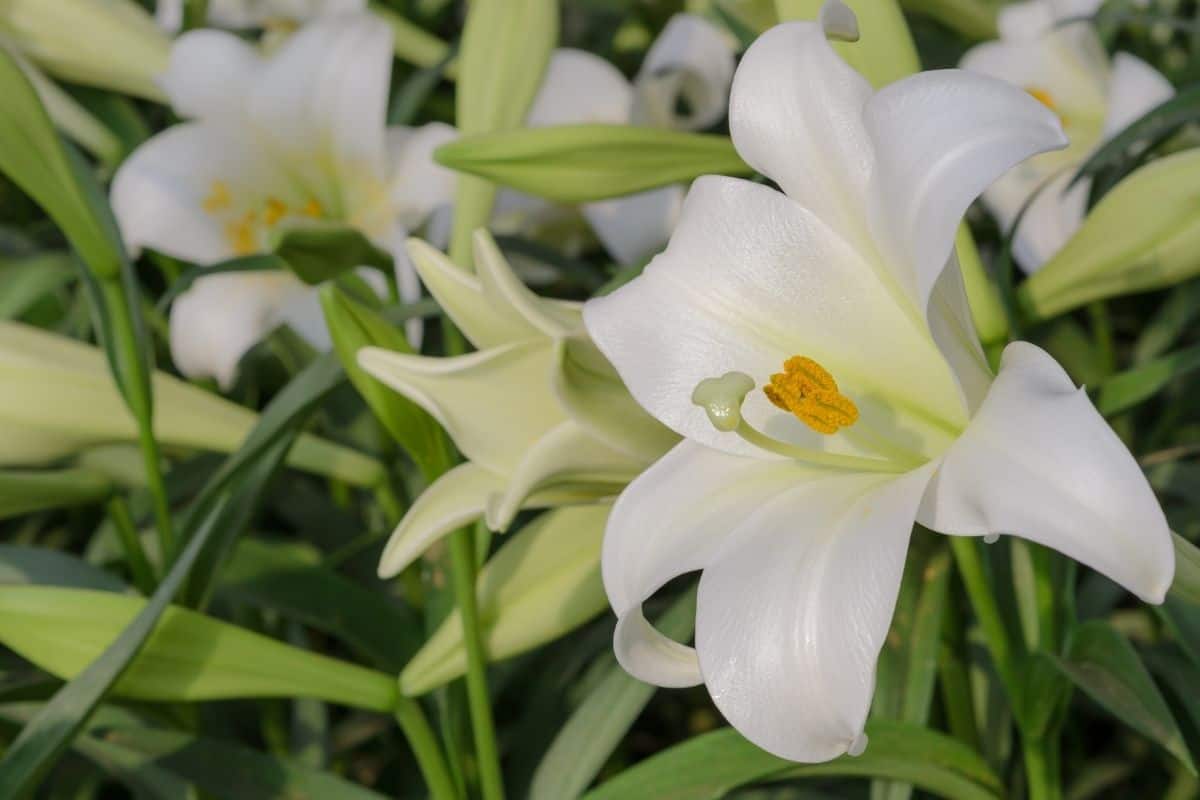
Division 6: Trumpet And Aurelian Hybrids
Trumpets and Aurelians are put into the same division. This hybrid division has the biggest number of varieties, which has led to them being very popular among florists and flower enthusiasts.
They have many visual qualities that make them popular too! Their foliage is slender and narrow, while the flowers themselves have the typical funnel shapes that you often associate with lilies.
The plants are large, too, and come in a variety of colors. They tend to open up around summer time, but will continue to grow and improve later into the year.
And their qualities aren’t just in sight – they smell great too! Trumpets and Aurelians have a wonderful, strong, refreshing scent to them.
Tending To Trumpet and Aurelian Hybrids
Many of the hybrids like to enjoy exposure to the full sun, so make sure that you’re planting them in a location that doesn’t have a lot of shade to it – you’ll want a good deal of heat to help them.
Additionally, plant them only in zones 4 to 8. As for their soil, you’ll want to plant them in a soil that has lots of organic matter in it.
And where is this soil going? Well, a container is best, as the hybrids will grow strongest here.
However, make sure that they are not placed too closely together, leaving about a 12 inch gap between the bulbs.
Once the hybrids have flowered, make sure to deadhead them (remove the dead plants) and then cut the plant back down to soil level before the winter comes.
Golden Splendor
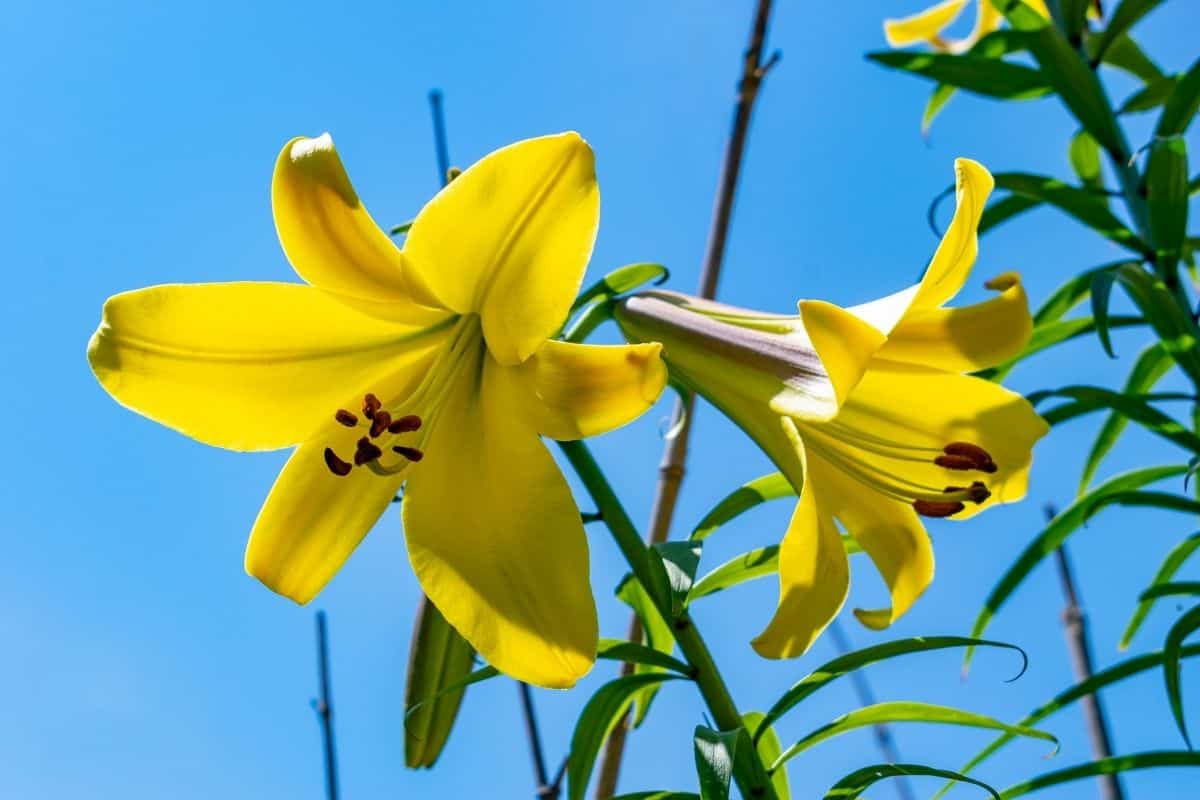
As you can tell from the name, these produced brilliant yellow (almost gold) flowers. It’s a sturdy plant with brown anthers, and has a little purple colored bud in their center.
They have a reasonable height, reaching about 4 feet usually, and bloom best in summer. They’ll want exposure to the sun! On top of that, they’ll grow best in the zones 4 to 8.
As you might assume from such a beautiful, refreshing looking flower, they have a heavenly scent. If you take a deep sniff inside this beautiful trumpet, you’ll enjoy a strong and delicious smell.
African Queen
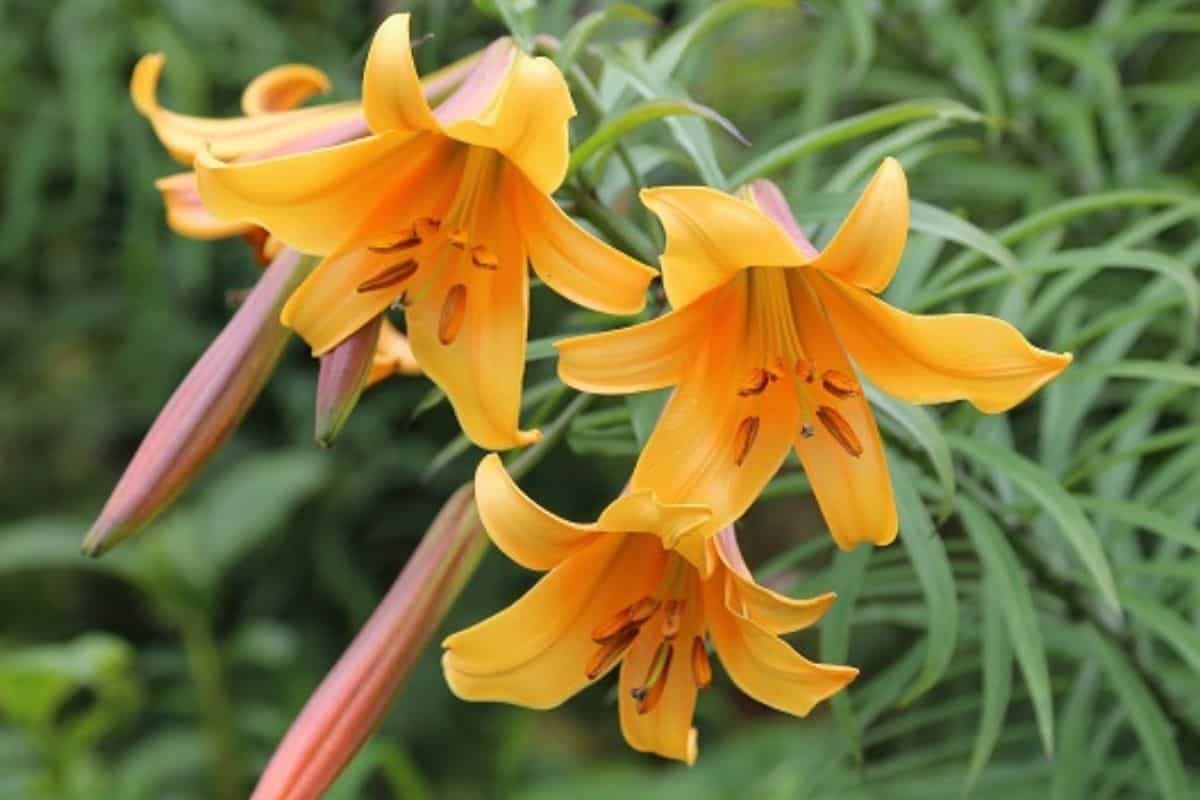
Beautiful and big, the African Queen (not the Humphrey Bogart movie!) comes in a vibrant and full on shade of orange.
The anthers, meanwhile, have a touch of purple and pink to them, which is a lovely contrast when compared to the orange petals.
The flowers themselves tend to face outward, while also dipping down towards the soil, as if they’re bowing to you.
They can reach a very impressive height of around 5 to 6 feet tall, so make sure to have plenty of room for them to grow up and into.
On top of that, they like to bloom in the middle of the year, best between July and August.
As a result, they like to enjoy the full sunshine, growing best when exposed to the light and the heat that those summer months allow in bucket loads. Make sure that their soil has good drainage though!
The African Queens also grows best in zones 4 to 9, and has a fragrant scent to it that you’ll love to smell.
Bright Star
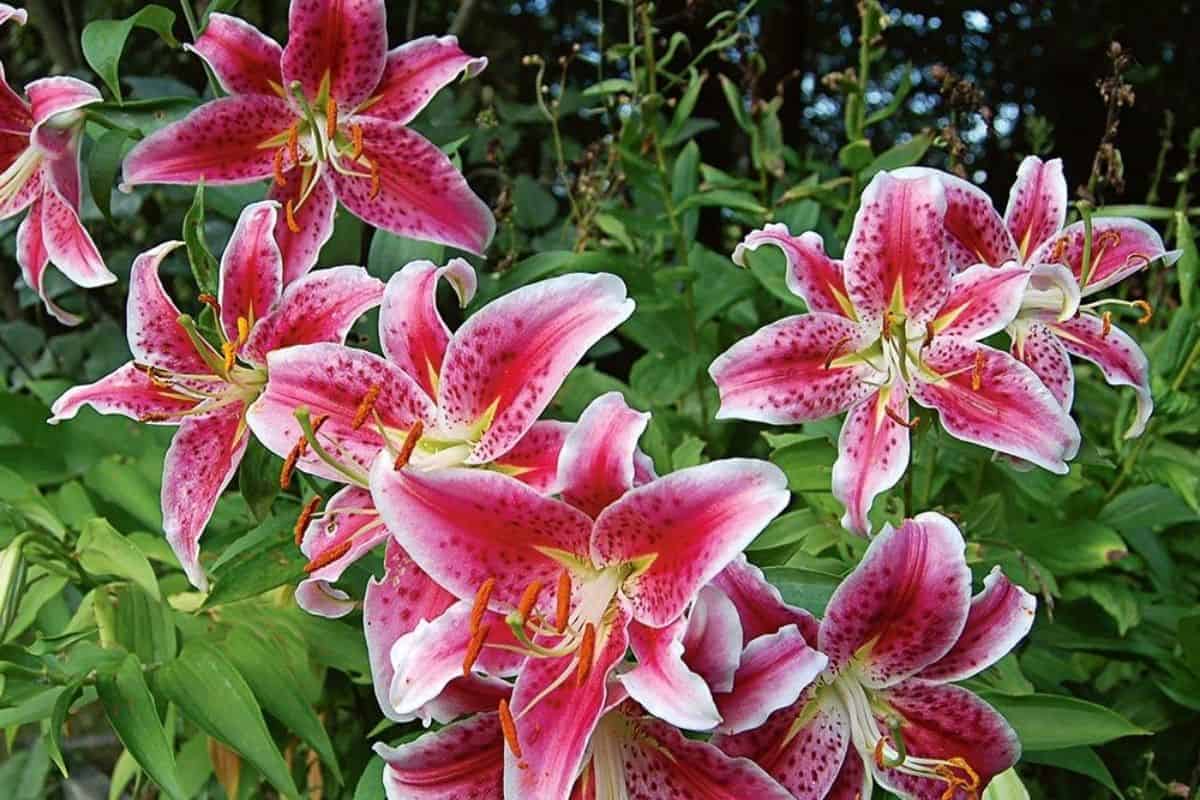
Another lily that shares its name with a movie! These beautiful flowers have a wonderfully subtle blend of white and pink on their leaves, with orange centers that look like little flames.
This is why they have their name, because their petals spread all around and they have these glowing orange anthers in the center – just like a golden, shining star in the night sky.
Interestingly, there are actually a bunch of green parts to the center too, adding a healthy look to it all.
The shape of the flowers are actually a bit flatter than other trumpet hybrids, because of the parent plants that formed it – the lilium centifolium and the lilium henryi.
They grow to a moderate height of about 3 to 4 feet tall, and bloom best in the period between later summer and early autumn.
This is a good, hot time that has plenty of sun – for this reason, it is a flower that likes to be put in the full sun, not hidden away in the shade.
On top of that, the flower grows best in zones 4 to 9, so it’s best not to try growing them if you’re not living in these areas.
On top of their exciting star-like appearance, they have a wonderfully fragrant scent to them too, meaning that they are not just lovely to look at but also nice to dip your nose into and smell.
Pink Perfection Group
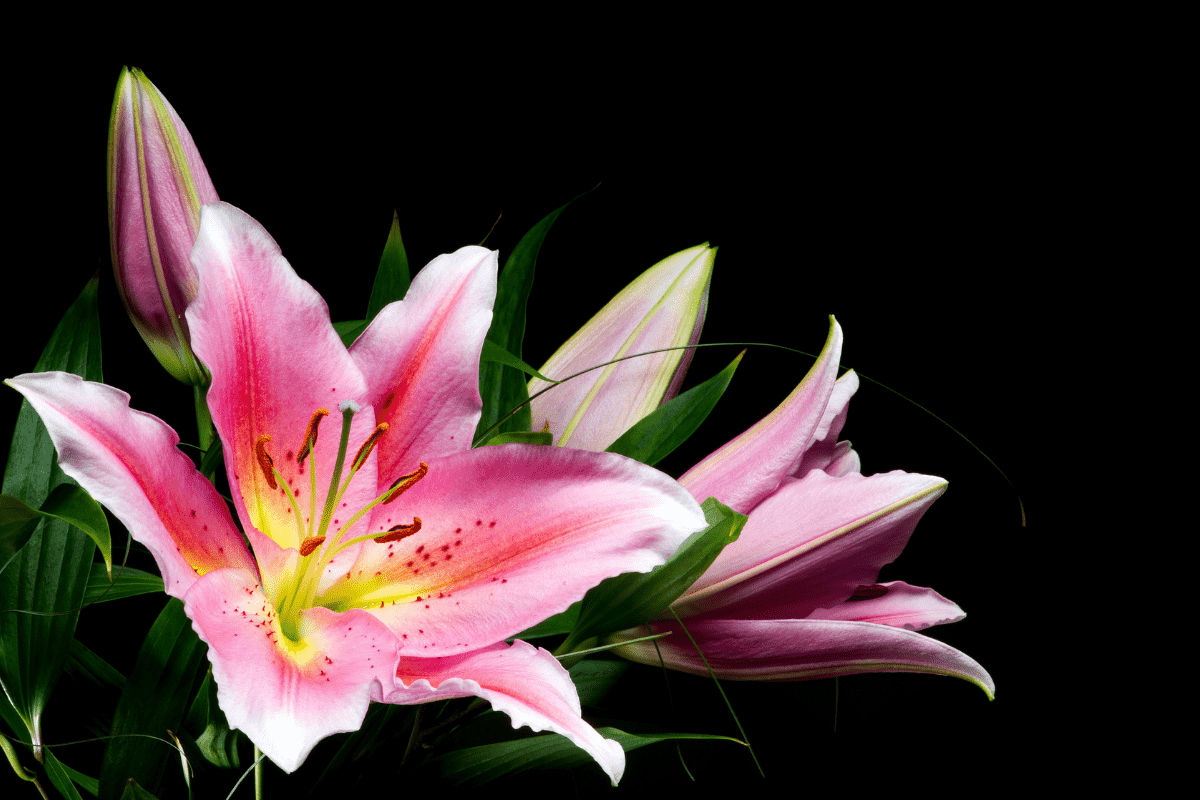
These are big flowers that have a really gentle, plush quality to their appearance. This is because they come in the shades of dark pink and purple, a full and relaxing color.
And what do we mean by big? Well, their flowers can be massive! Some of them will measure about 10 inches (0.8 feet) in their diameter, at their absolute maximum growing size!
But to reach that size you’d better plant them properly! Thankfully, they are versatile, growing equally well in containers and flower beds. When do they grow best, though?
They should bloom best around summer time, whether in the middle of the season, or towards its end. Since that’s a hot time, they like heat, and they enjoy being planted in view of the full sun.
That being said, they also do well when put in partial shade. Like we said, they’re versatile!
Pink Perfections grow best in zones 4 to 9, so make sure to have this kind of environment if you expect them to survive and grow to their best size and conditions.
On top of this all, they are a very fragrant plant, with a rich and beautiful scent – which fits their beautiful purple look.
Division 7: Oriental Hybrids
These hybrids come from blending the lilium auratum and lilium speciosum, which are types of wild lilies, a division that we’ll speak about later.
Like those parent plants, they look wonderful and have brilliant, fragrant scents to them – making them very popular among flower growers.
Interestingly, they actually turned out to be better than their parents, being a lot sturdier and hardy.
They usually reach great heights, even as much as five feet, and their blooms are usually somewhere between six and eight inches (0.5 to 0.6 feet).
Additionally, their petals are curved, and the flowers themselves are strong and face upright.
They are often at their best around August time, but they start to bloom in summer and sometimes last long into fall.
Tending To Oriental Hybrids
You must be careful when choosing soil for your oriental bloomers.
They don’t like lime for a start, which some soils have to improve their soil structure, so you’ll want to go for an ericaceous compost soil instead.
Lime heavy soil is often called alkaline, so be sure to watch out for it. Additionally, your flowers will do better if you put them in containers.
Dizzy Lily
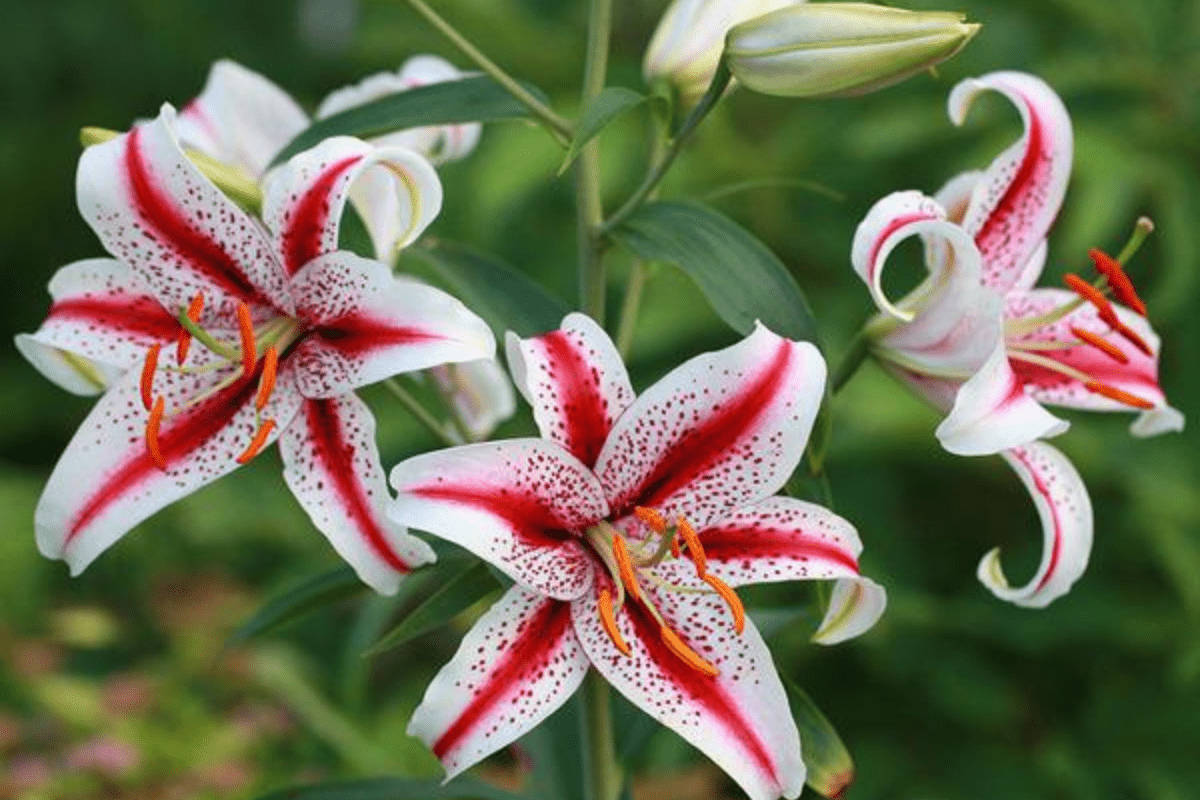
These have lovely long petals that are white, with deep red lines stretching across them down the middle. Alongside that, there are lots of pink and red spots all around the petal.
It all creates a flower that is very pretty and delicate, which is further helped by the red or pink anthers hanging from the center of the flower.
As for the shape, the petals like to curve backward, which makes them look even more delicate and soft.
The plant can grow to heights of 3 to 4 feet tall, which isn’t especially high, but is high enough to still have its charm.
Dizzy’s are versatile too, able to grow well in flower beds and containers.
Similarly, they are happy to grow whether they’re in full sun or whether they’re being kept cooler in some shade – so feel free to mix it up!
As for zones, they grow best when planted in a place that come under zones 5 to 9. And season wise? They will bloom best around the middle of summer.
As for their soil, you’ll want a soil that has good drainage, but is regularly kept watered – but never drowned.
Oriental Acapulco Lily
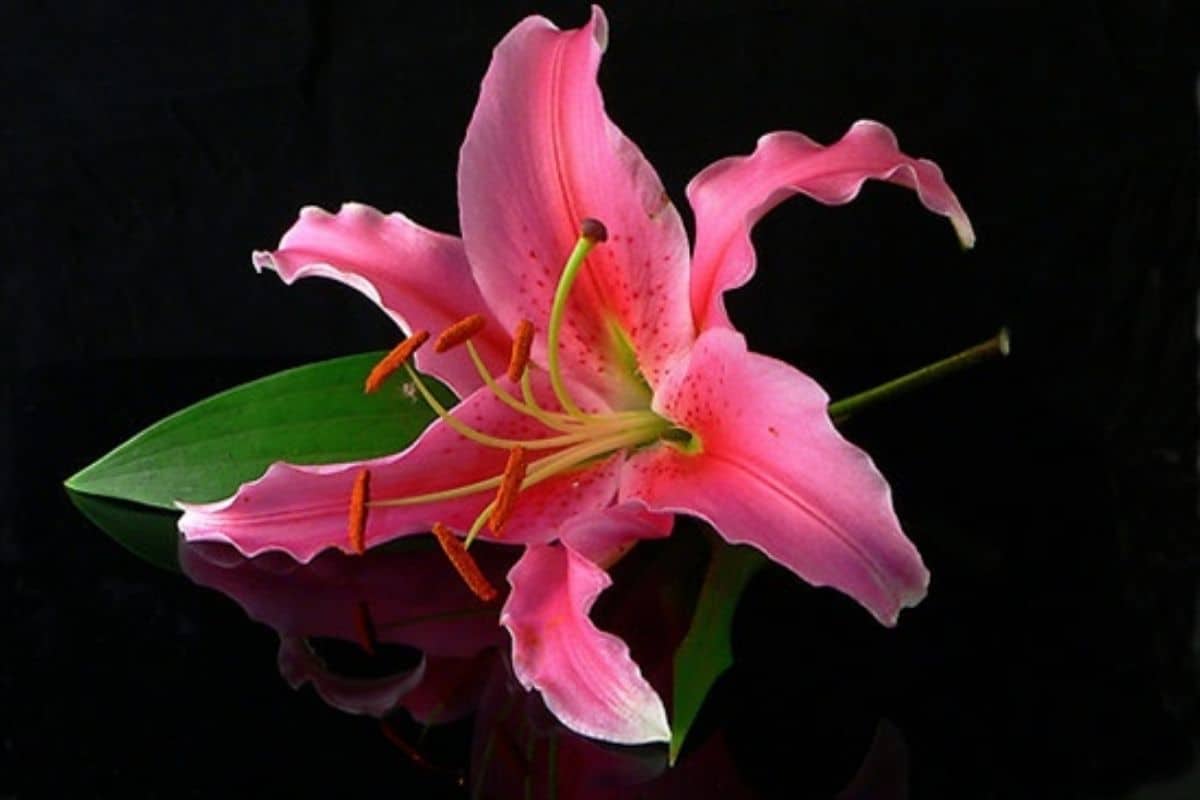
This is a beautiful and bright pink lily, with a really full color to it, helped by little dark pink spots all over it.
The anthers are delicate golden colors, and the petals of the flower are slightly ruffled, making them appear even more gentle.
These hybrids bloom best in the middle or end-half of summer, and enjoy being put in the full sun or in some partial shade. As for the locations in America that they are likely to grow best when planted in, the Acapulco lily should grow best in zones 3 to 8.
They have a moderate height, too, able to reach anywhere between 3 and 4 feet in height. And the smell? Lovely! They have a fragrant scent to their flowers.
Casa Blanca Lily
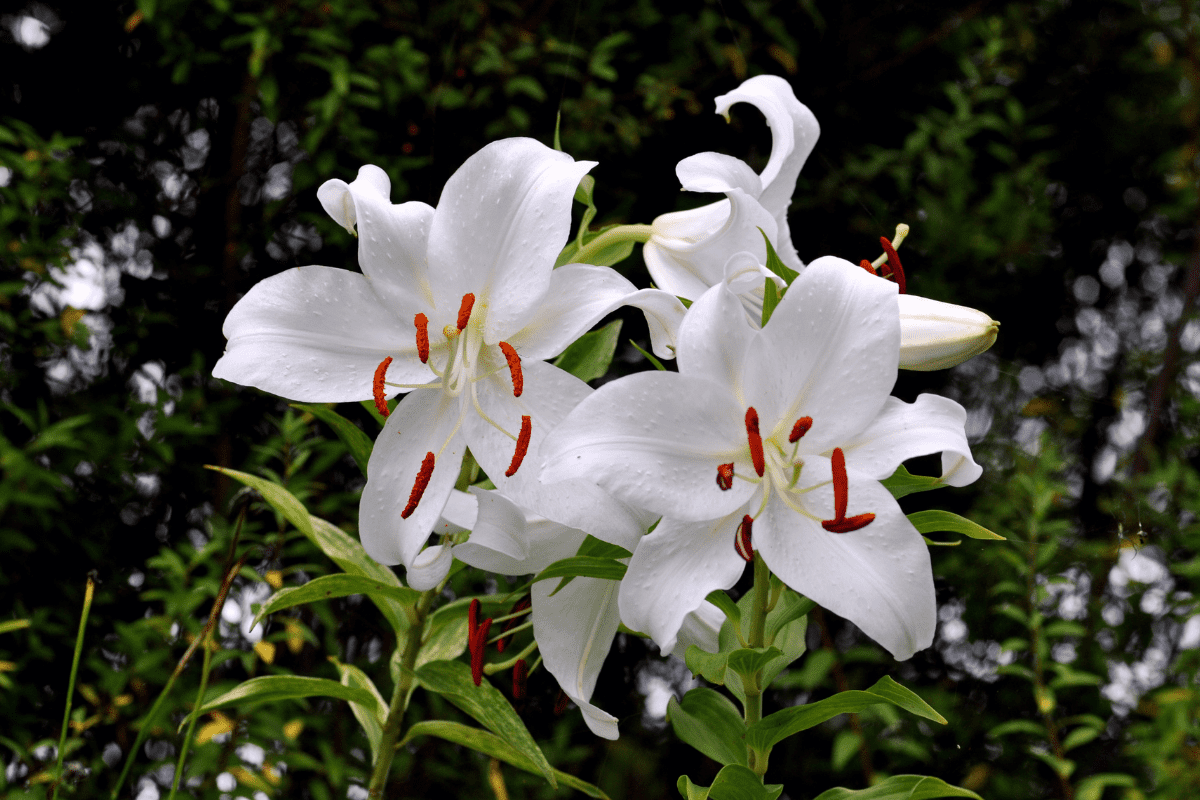
What do you know, another lily that shares its name with a Humphrey Bogart movie! Well, no, it’s obviously really taking its name from the place in Africa!
These are pure white flowers with no dots or spots, just sheer white petals with orange or gold colored anthemes hanging out of their center. On top of that, the center also has dashes of green around it.
They like to bloom best between the middle and the end-half of summer, enjoying being put in full view of the sun.
Try to avoid the shade! They like light. That being said, they should be planted in slightly colder zones like zones 4 to 7. Those are still relatively warm, though, and should have plenty of sun!
Casa Blanca lilies can grow to heights of about 3 to 4 feet tall, and have a lovely fragrance to them too.
Tom Pouce Lily
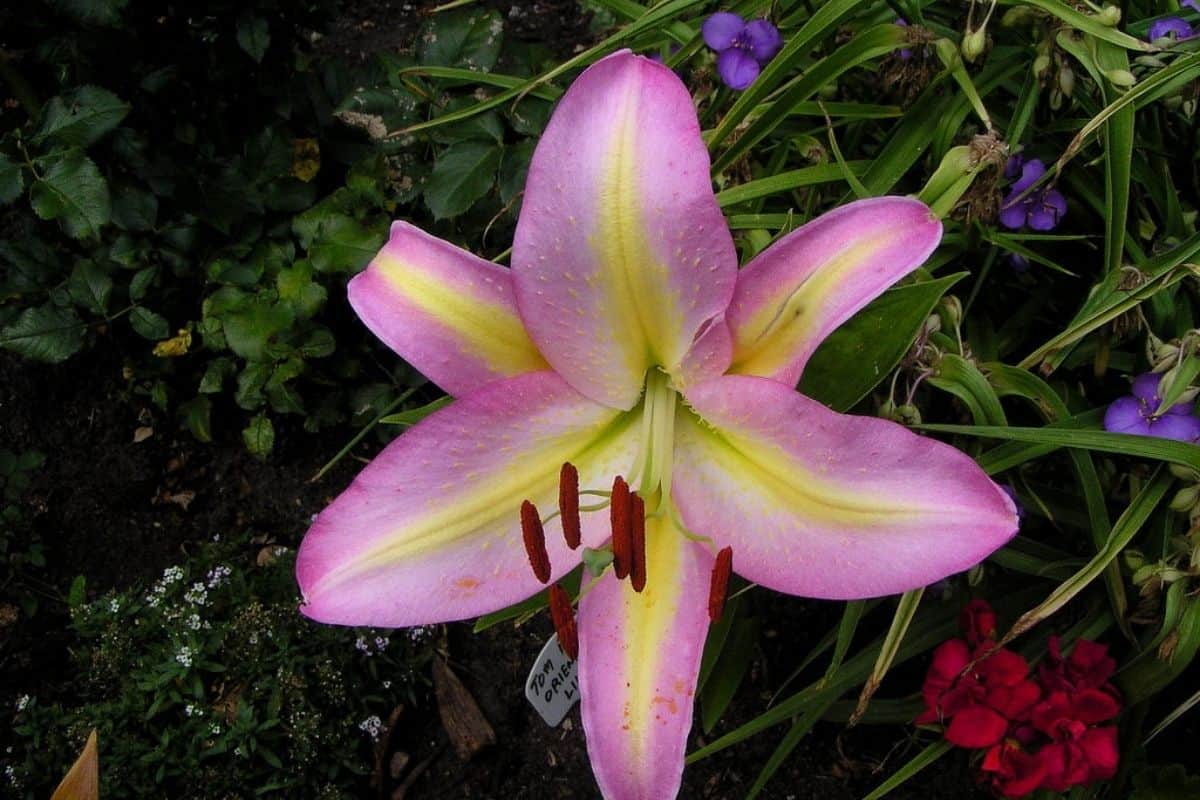
These are gorgeous lilies with one of the most unique styled flowers there are.
Basically, they have soft pink petals with a yellow stripe on each that goes down the center, lengthways down the petal. Meanwhile, their center has a mixture of green alongside the reddish anthers.
Sometimes they’ll have spots too. The pairing of purple and yellow is peaceful in unexplainable ways, so have a look for yourself!
They do well blooming in containers, with soil that is well-drained.
They bloom best around the middle and end-half of summer, and enjoy either full sun or a bit of shade. As for zones, you’ll want to grow them in hardy, hot zones of 5 to 9.
Tom Pouce can grow to heights of 2 to 3 feet tall, and offer a delicious fragrance.
Division 8: Interdivisional Hybrids
These hybrids are made by crossing flowers from the other 7 divisions, making them almost a blend of blends.
This ability to cross them has only been made possible by science in recent years. They tend to have large flowers which are flat. Unlike many other lilies, they are okay with soil that contains lime.
Black Beauty Lily
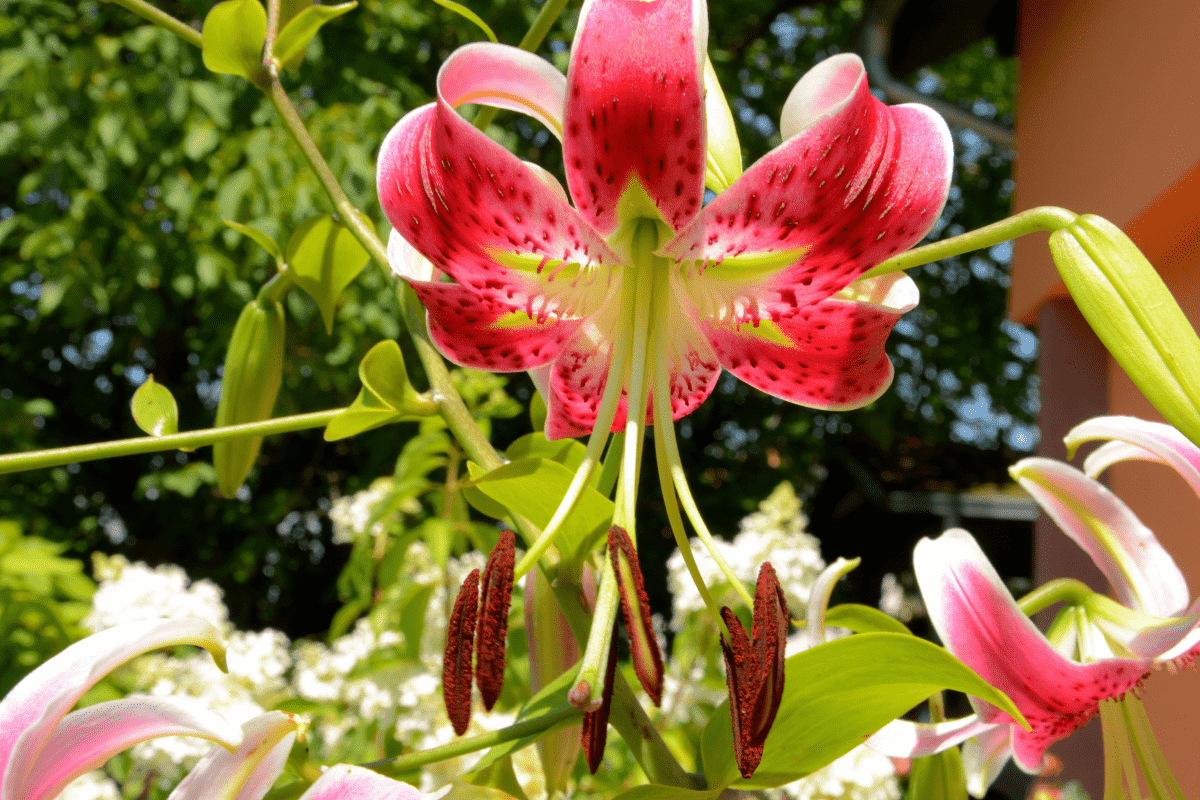
You may expect these to be solid black, but no! They’re a kind of pink shade that grows darker as it gets towards the center. On top of that, they have little spikes that are dark purple.
Make sure you have room, because they tend to grow a lot of flowers – as many as 150! As a result, they have very big bulbs that can support the great amount of buds and flowers.
And moreover? They have a great scent!
Their height is quite impressive too, reaching 4 to 6 feet tall. They enjoy being in the full sun, blooming in late summer and early autumn.
They like to grow in hardy zones, growing best in zones 4 to 9. On top of this, they don’t mind growing in alkaline, lime-heavy soils.
Scheherazade Lily
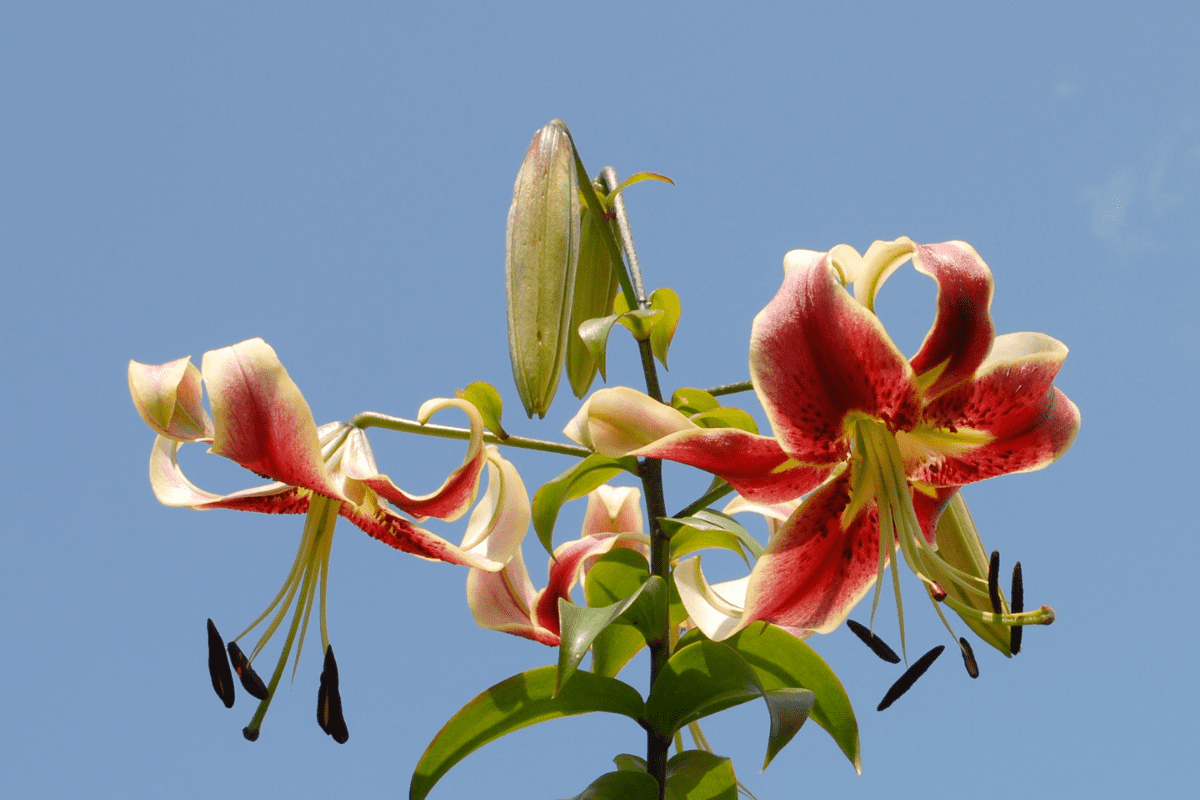
It may be a mouthful to say, but these are quite beautiful. The flowers are a rich crimson color, with a cream-like border going around the petals.
The anthers come out of the center at a great length, each one brown.
The lily blooms best in the middle or end of summer, and is happy to enjoy some shade or full sun exposure.
It can grow to 4 to 7 feet tall, and grows best in the zones 5 to 9. On top of that, it smells very fragrant!
Heartstrings Lily
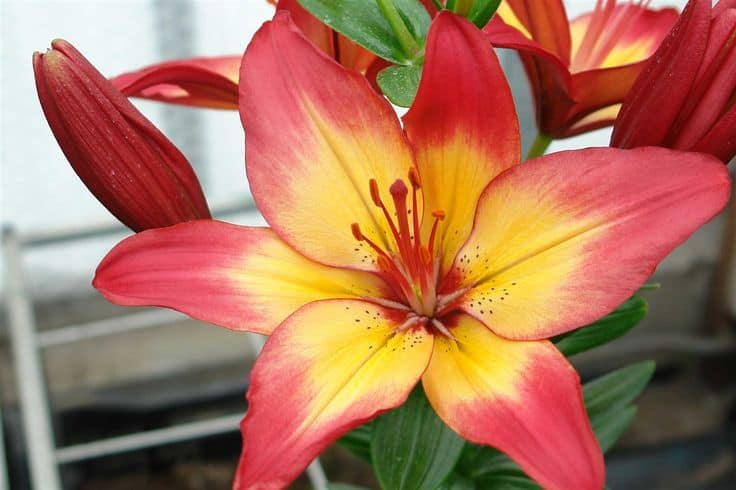
These are pink, like a cartoon of a heart, with white sections near the center. They bloom best mid-year, in June, and enjoy being in the sun or in the shade.
They can reach heights of 3 to 4 feet tall, and grow best if you put them in zones 3 to 9.
Make sure to pop them in some soil that’s drained well, and water regularly – but not too much. When they’re fully flowered? They should smell very fragrant!
Forza Red Lily
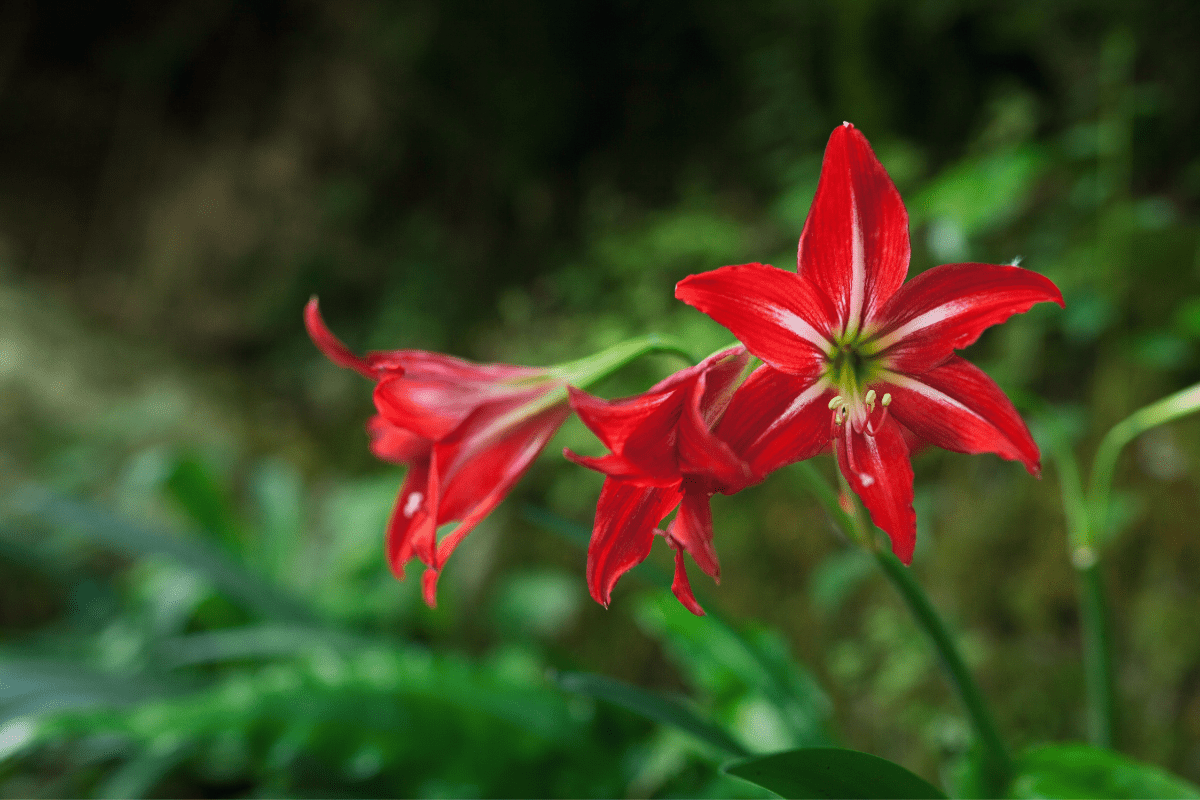
You can guess the color of these lilies – they’re red! It’s a really luxurious looking red, too, deep and rich.
They actually look quite a lot like red velvet, all smooth and expensive looking. Their center contains dark red anthers, adding a small and subtle contrast in shades, making them look even better.
They have large blooms and can reach heights of 3 to 4 feet tall. They bloom best in the middle of the year, in June, and enjoy being put in the sun.
Try to let them avoid being in the shade! They like heat and light. They will grow best if you plant them in a place that is between zones 5 and 9.
On top of looking wonderful, they smell brilliant too! As you would expect from such a fancy looking plant. It’s no wonder that they’re popular with flower sellers!
Division 9: Wild Lilies
Finally, we reach the 9th division.
These are the wild parents of all the other 8 hybrid groups, and the native lilies can be found in a variety of places: North America, Europe, and Asia. Sadly, though, they can be harder to grow in your garden than the hybrids.
They may not look as flashy as the hybrids, which get the best of both worlds because they get to blend two lovely plants together, they still have a lot of beauty and color in them.
They can be grown in much the same way, although make sure to avoid alkaline soils, but it will be more difficult to keep them alive and growing than when you’re raising some hybrid lilies from the other divisions.
Leopard Lily
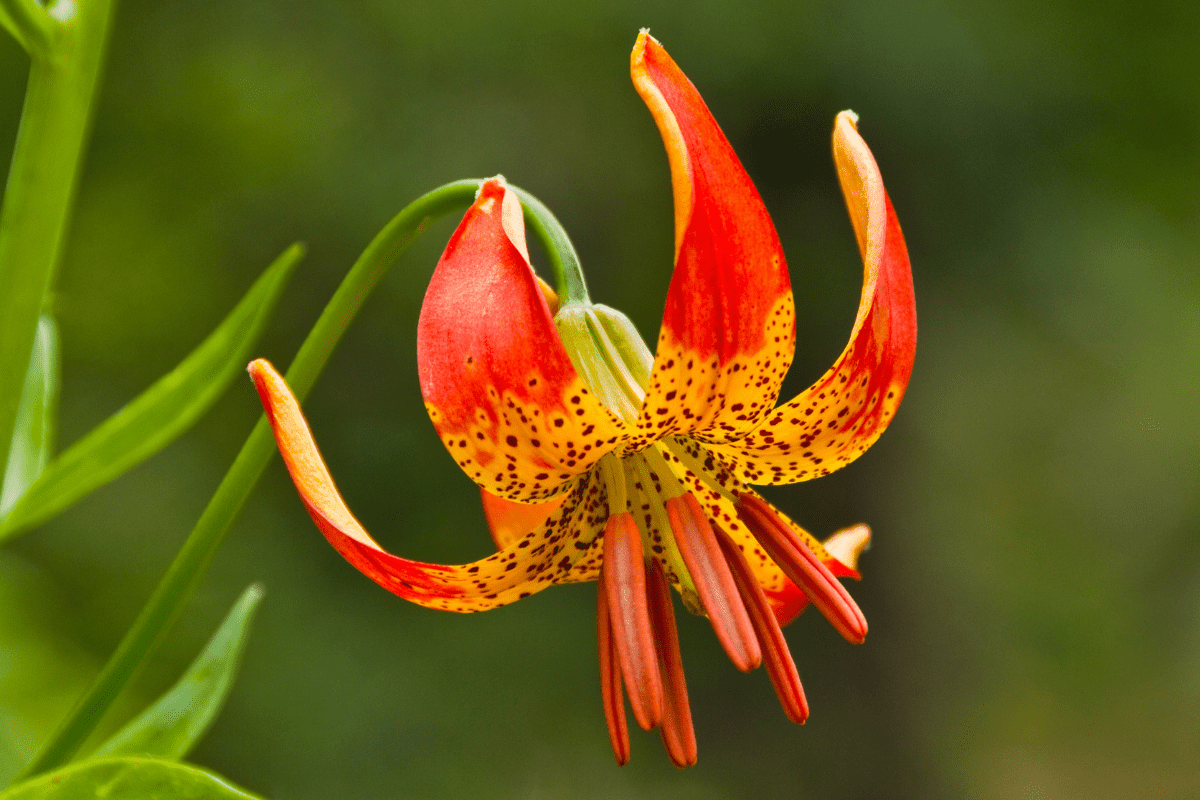
These originally come from the pacific coast region of North America, from places like California and Oregon. They are a delightfully vibrant and spotty flower.
Their petals are a mix of yellow and orange, while being shaped like a pendent, and they have lots of dark red spots and dots all over them.
This is, understandably, where they get their name from – because they look like leopards, yellow with spots!
They do well in both partial shade and partial sun, so be sure to give them a good mixture, and they bloom best in the middle of summer every year.
As for the zones across America that they’ll grow best in, you should plant them if you’re living within zones 5 to 9.
They can grow to heights of about 5 to 6 feet tall, and they are often fragrant in their smell – though it may not be as strong as other lilies or lily hybrids.
Tiger Lily
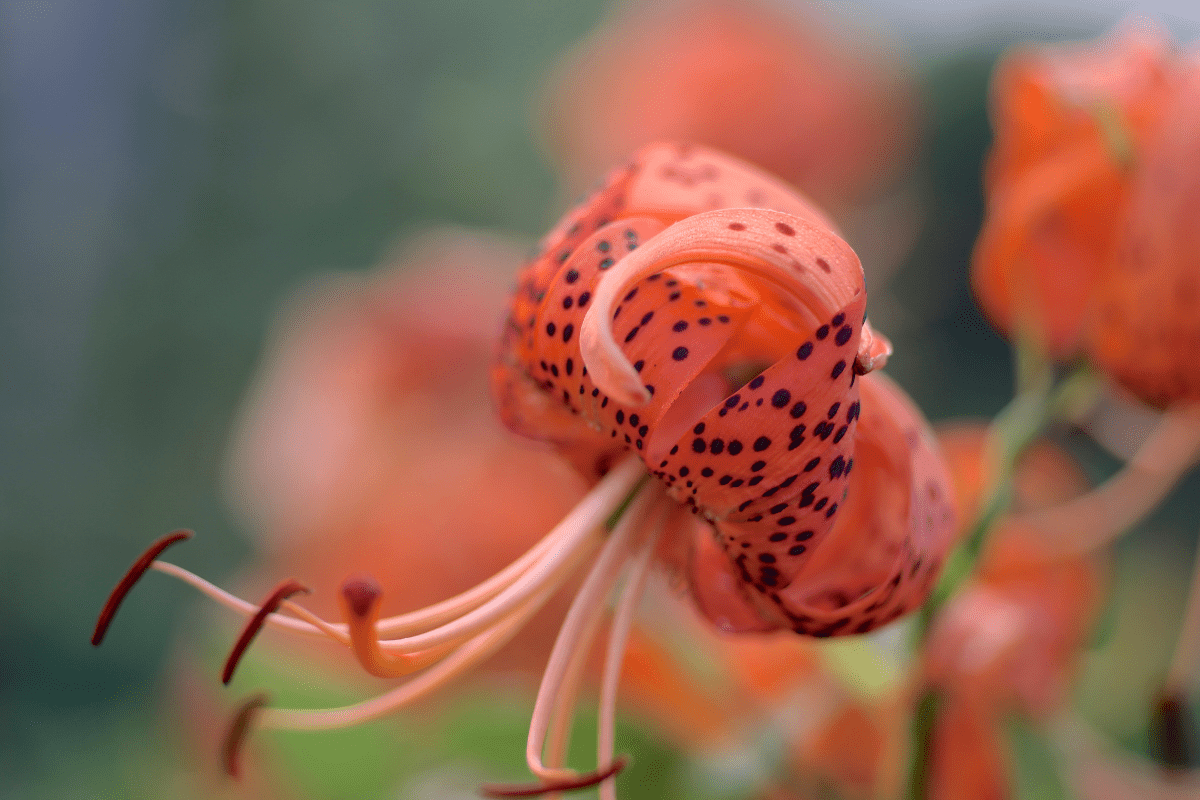
Now, these have a similar name to the Leopard Lily, and I bet you can guess why! That’s right, they have a color like a tiger, along with spots – just like the animal too!
The color is, naturally, orange, which gets lighter as it goes out towards the edges of each petal.
As for the spots, they tend to be dark red and brown in color, though it can also look a lot like dark purple – not a color that a tiger would have! Their anthers, meanwhile, are also purple/brown.
These lilies originally came from Asia, but now grow all over North America. They’re sturdy plants, too, able to survive most viruses or diseases.
This does, however, make it risky to plant them next to other plants – so make sure that you give them space. A big garden will make this easy.
Speaking of garden size, you can easily have lots of the tiger lillies!
They have small bulbs at the axis between their stems and leaves, which you can remove when they are easy to pull away, before planting them into other pots.
It can reach heights of about 2 to 5 feet tall, leaving big room for variation. They grow best in zones 3 to 9, and bloom in the middle or the end of summer. They like the sun a lot, so give them either full or partial sunlight.
A downside, though, is that the tiger lily is not fragrant. For such a beautiful flower, it’s a shame that it doesn’t have a lovely scent to accompany its looks.
Martagon Lily – Lilium Martagon
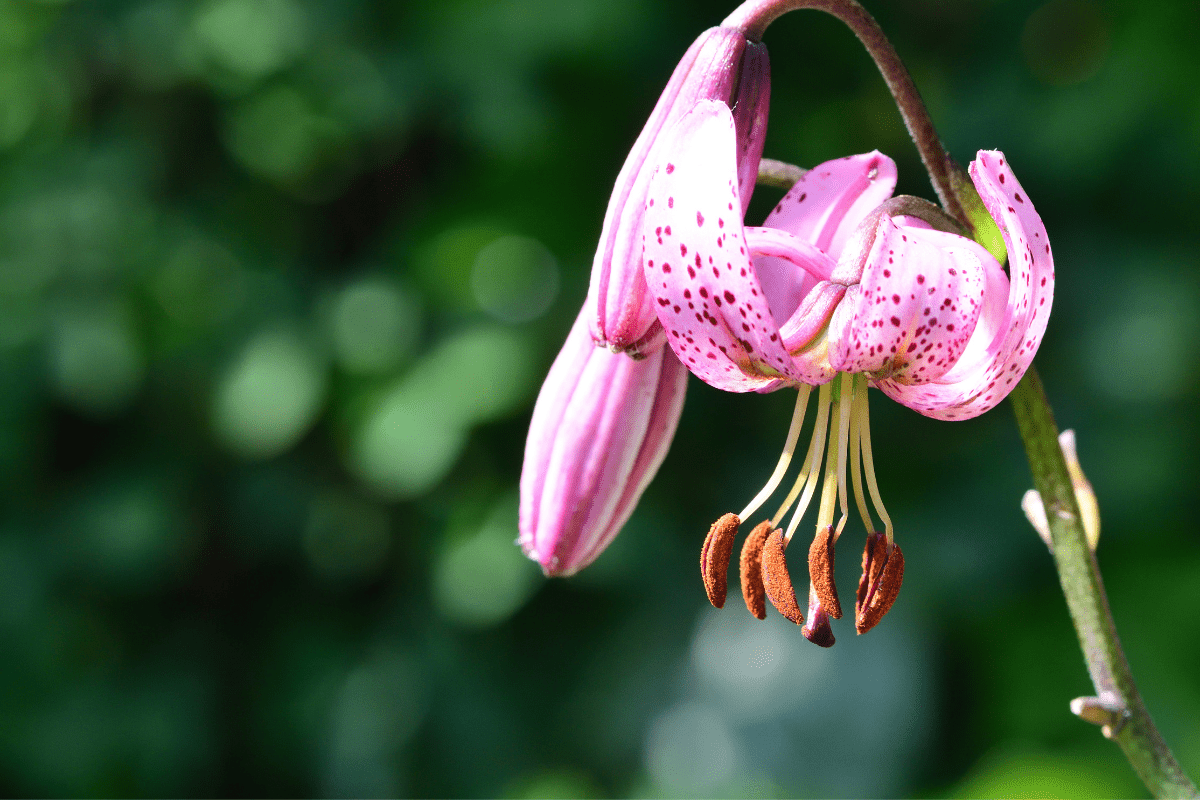
This usually comes with purple and pink leaves, (typically) with dark purple spots all over it and orange anthers, but you can also get it in an albino white form. A big contrast!
The pendent leaves curve back on themselves, touching the bottom of the flower.
What’s impressive about the martagon is that you can plant it and it “goes native”, which means that it establishes itself in your garden and can keep going for years without too much tending.
It is also a type of lily that likes to be in the shade, growing well without the sunlight if you want to plant it that way.
On top of that, it doesn’t mind too much what kind of soil you’re planting it in, either.
If it’s alkaline and lime soil, it won’t react negatively like many other lilies, being able to grow unlike its hybrid off shoots.
Canada Lily – Lilium Canadense
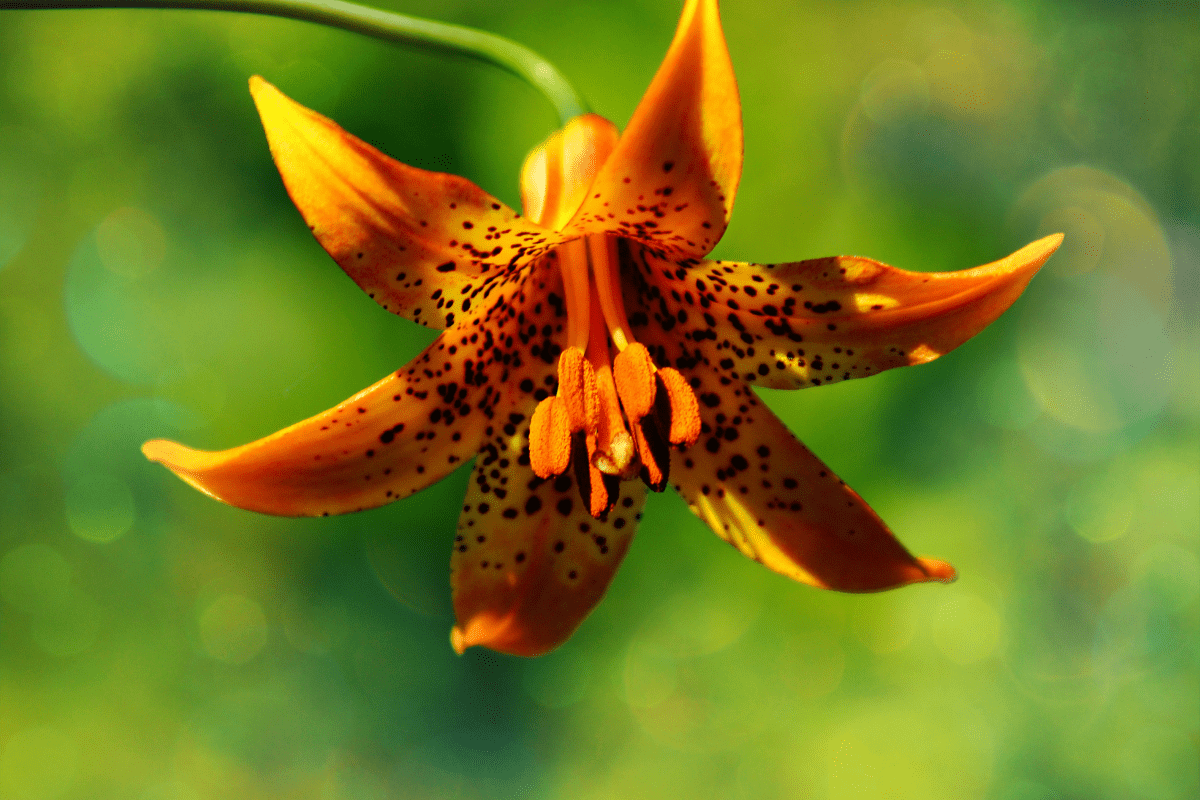
These actually look a lot like tiger lilies, with orange leaves and beautiful brown and purple spots all over them. On top of that, the anthers have a certain purple shade to them too.
The leaves have pointed tips that go out and bend up, making the flower quite elegant, unlike the big trumpet lilies that you may have seen.
The Canada Lily is quite unique in its bulbs, which are stoloniferous. This means that instead of growing out of the top of their bulb, the plant grows out of the base of the bulb for a few inches.
New bulbs are then formed at the ends of these base shoots, which then start to grow up towards the surface.
These like to bloom in the months of June and July, and enjoy being in the full sun. They grow in a whole range of zones, zones 3 to 9, so you’ll likely be able to grow them wherever you live across America.
That being said, they aren’t easy to grow and keep going, so maybe get some experience in growing lilies before you turn your hand (and its green fingers!) to growing some Canada Lilies.
But if you do manage? These beautiful plants should grow to heights of about 4 to 6 feet tall. However, they sadly do not have a fragrance to them, so you’ll have to enjoy their looks alone.
Fire Lilies
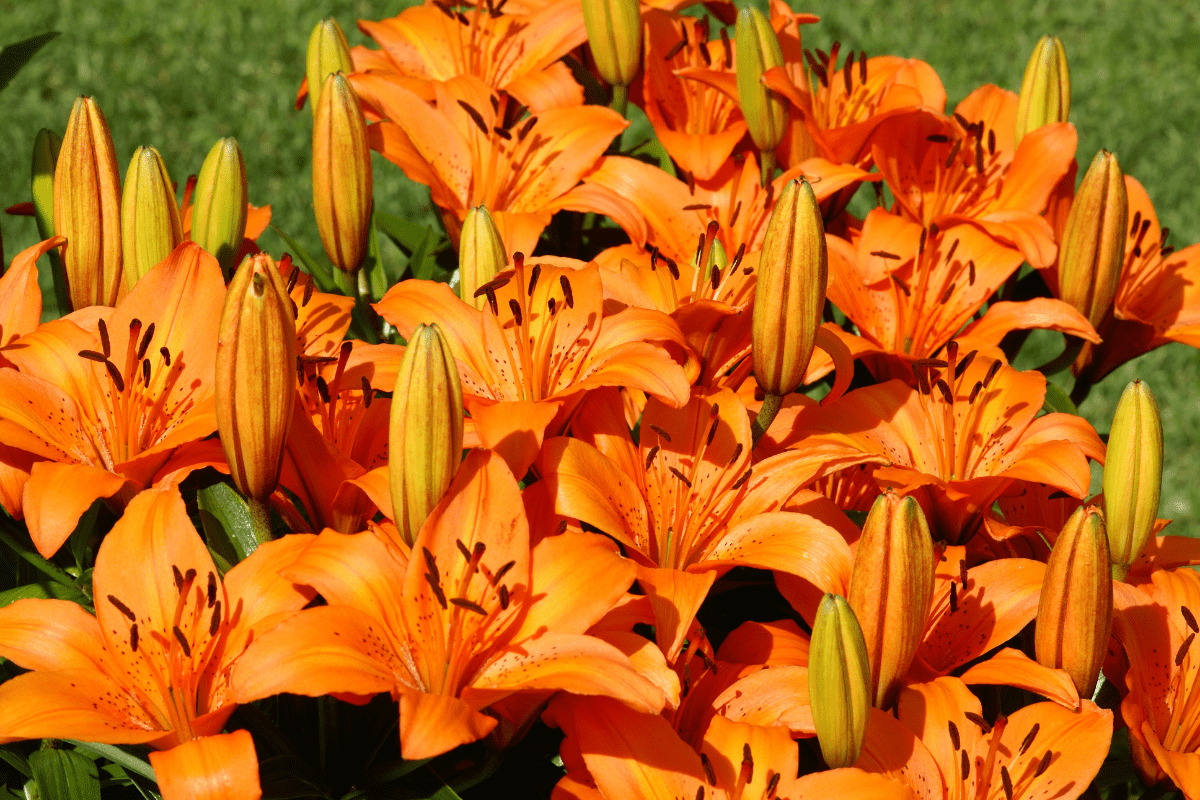
As you can guess, these are orange colored plants that look like fire! The flowers open wide like a bowl, and their petals are covered in dark brown spots.
They grow only about 3 to 4 feet tall, making them rather small, but they are beautiful nonetheless. Better yet, they’re easy to grow!
They have numerous bulbils that form on the area between their stem and leaf, which you can remove and pot to make more fire lilies in no time.
They bloom best in early summer and enjoy being in full or partial sun.
For zones, they will grow best in zones 3 to 9, which is again a big gap – meaning you should hopefully be in one of them. On top of that, they’re very fragrant flowers!
Easter Lily
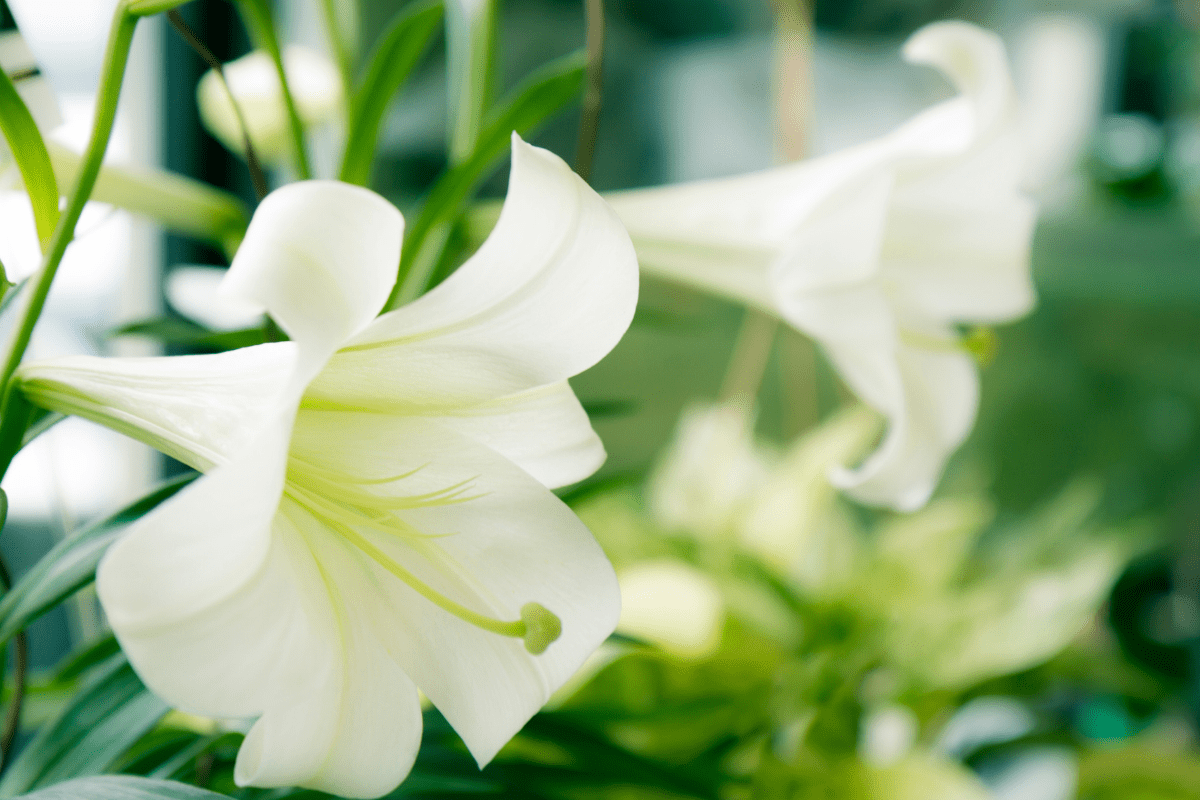
We’ve mentioned these earlier, under the Division 5 hybrid. These are pure and white, and help to make hybrids like “White American”.
Their anthers are golden brown, and the plant will grow only to a height between 2 and 4 feet tall.
They bloom best in late summer, but this is when they’re planted outdoors.
See, if you live in a warm area, then you can grow them outdoors easily, where they like full or partial sun, but if you live in a colder area then you’ll need to grow them in containers that can be brought inside in winter.
Zones 5 to 8 will be best, and the plant is fragrant for your troubles.
Henry’s Lily
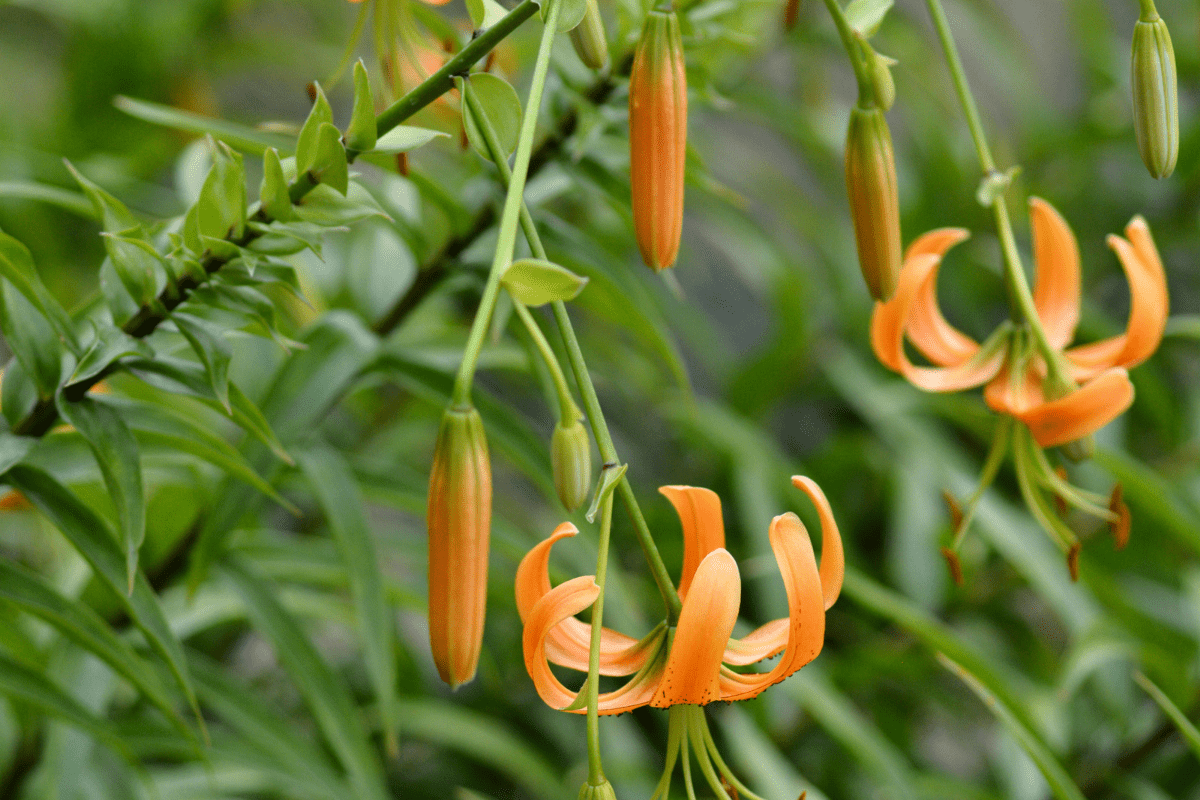
This is a beautiful, curved flower with orange petals and brown dots. It’s very hardy, growing in zones 5 to 8, and enjoys any soil.
It grows to heights of 4 to 8 feet tall, and blooms best in the beginning and middle of summer. It benefits from full or partial sun.
Sadly, it has no fragrance!
Golden-Rayed Lily – Lilium Auratum
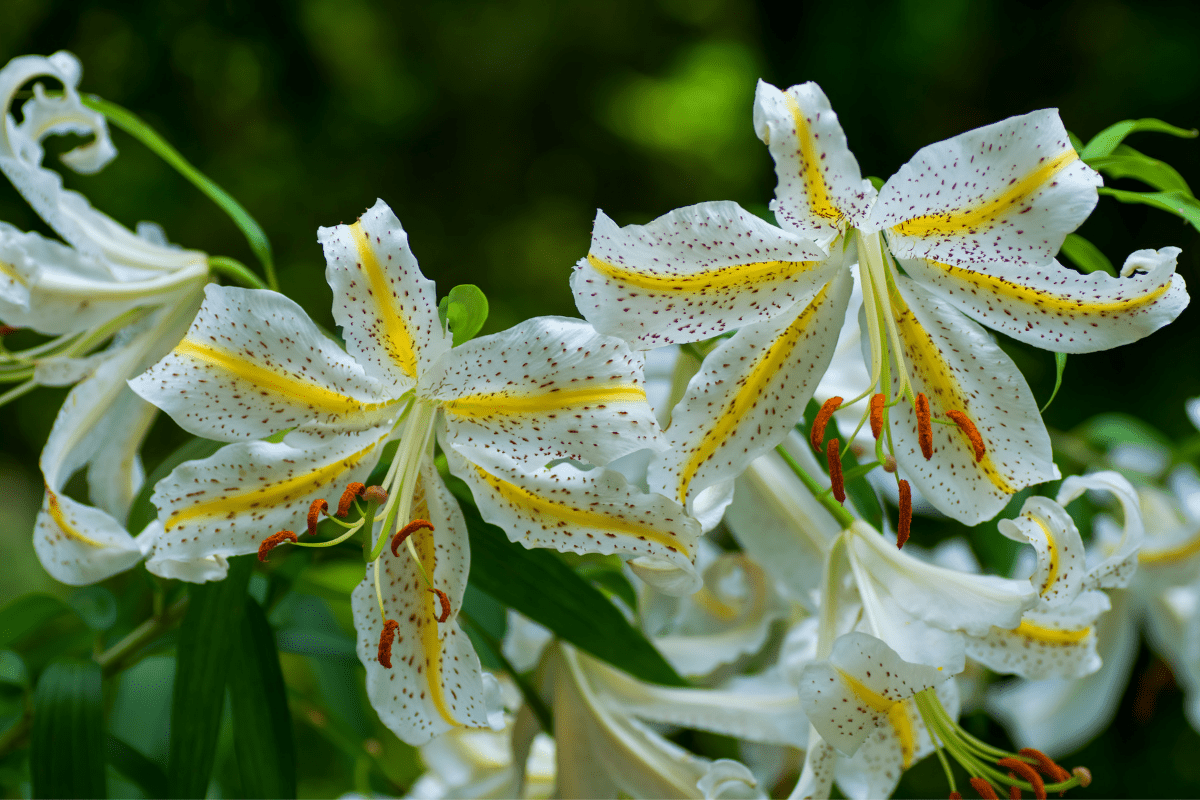
These have soft white petals, with yellow stripes and brown spots. They dislike lime soil, so use ericaceous compost, with grit for drainage.
They can grow to 4 feet tall, and bloom in late summer, enjoying full or partial sunlight.
It’s best to put them in a container, and try to plant them in a place between zones 5 and 10.
Madonna Lily
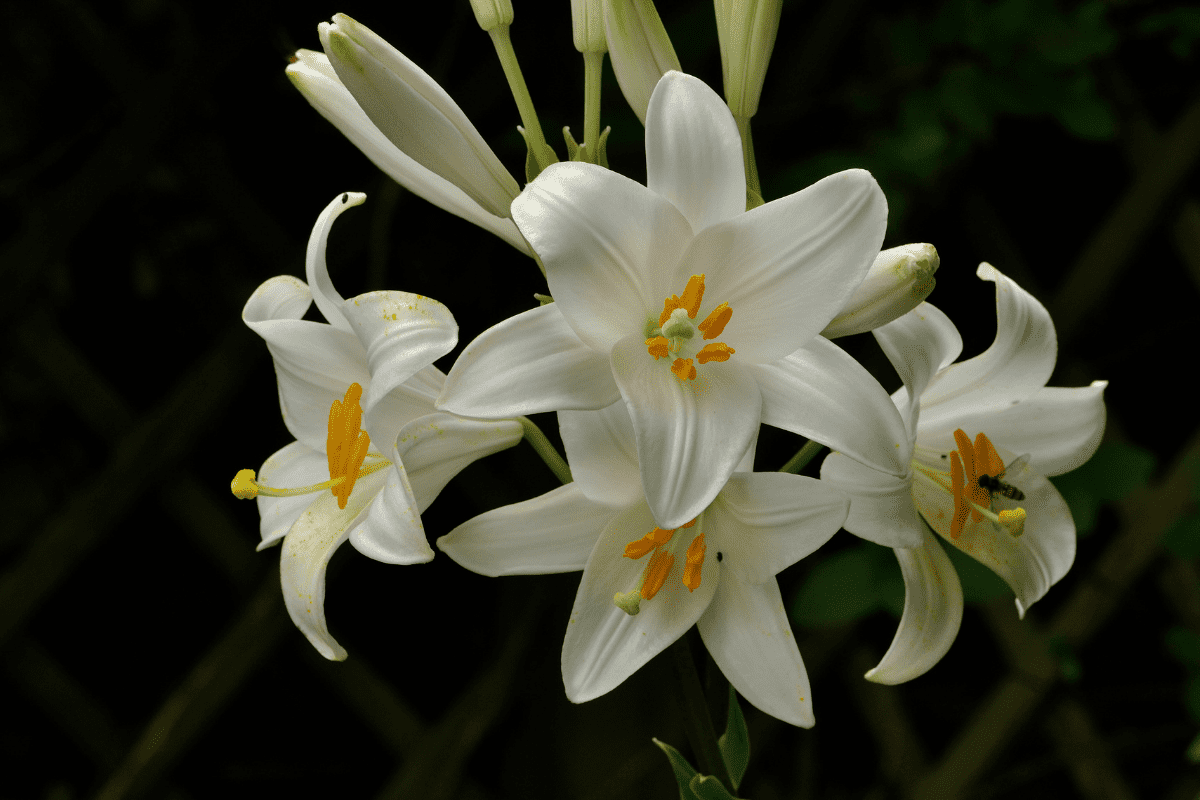
Let’s finish with the classic. They enjoy any soil, as long as it’s well-drained, and bloom in early summer. They have pure white petals with a green center.
Try to grow them in zones 6 to 9, and make sure that they’re planted a little shallower than usual. They enjoy full and partial sunlight, and will give you a beautiful fragrance.
How To Breed Lily Hybrids
Step 1
Remove the anthers of the lily you’re pollinating (the seed parent), but leave their style/stalks.
Step 2
Remove the anthers from the second lily parent (the pollen parent), putting the pollen onto the end of the seed parent’s stigmas. Be careful and use a paintbrush for help.
Step 3
Once pollinated, label the plant to remember. If the two plants don’t bloom at the same time, just put the pollenin the fridge until the second plant flowers.
Step 4
Wait a few weeks! For safety, but some muslin around the pod, so it collects the seeds.
Step 5
After collecting the seed, you can plant them into neutral pH or ericaceous compost.
Plant them on top and give them a dusting of compost, then soak in water from the bottom. Put it all in a plastic bag, and a lily should appear within weeks!
Final Thoughts
As you can see, there are loads and loads of different lilies – whether they are the originals or hybrids!
Adding lilies to your garden will instantly make it more beautiful, with so many different colors available, and our guide has shown you how relatively easy they are to grow and keep.
So, follow our steps, and you’ll have a beautiful garden in no time!

